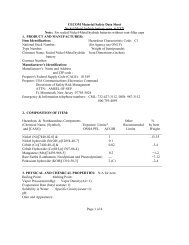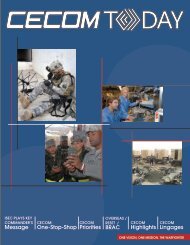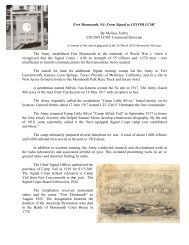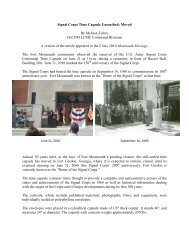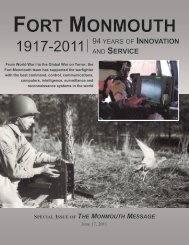A History of the Commanding Officers at Fort Monmouth ... - CECOM
A History of the Commanding Officers at Fort Monmouth ... - CECOM
A History of the Commanding Officers at Fort Monmouth ... - CECOM
Create successful ePaper yourself
Turn your PDF publications into a flip-book with our unique Google optimized e-Paper software.
A <strong>History</strong> <strong>of</strong> <strong>the</strong><strong>Commanding</strong> <strong>Officers</strong><strong>at</strong><strong>Fort</strong> <strong>Monmouth</strong>, New Jersey and <strong>the</strong>U.S. Army <strong>CECOM</strong>Life Cycle Manangement CommandPrepared by <strong>the</strong> Staff <strong>of</strong> <strong>the</strong><strong>CECOM</strong> LCMC Historical OfficeOffice <strong>of</strong> <strong>the</strong> Deputy Chief <strong>of</strong> Staff forOper<strong>at</strong>ions and PlansU.S. Army <strong>CECOM</strong> Life Cycle Management Command<strong>Fort</strong> <strong>Monmouth</strong>, New JerseyFall 2007Design and Layout byCTSC Visual Inform<strong>at</strong>ion Services, Myer Center<strong>Fort</strong> <strong>Monmouth</strong>, New JerseyVisit our Website: www.monmouth.army.mil/historian/
COMMANDING OFFICERS1. LTC Carl F. Hartmann June 1917 - July 19172. MAJ George E. Mitchell July 1917 - Sept 19173. MAJ Arthur S. Cowan Sept 1917 - June 19184. COL George W. Helms June 1918 - Dec 19205. LTC John E. Hemphill Dec 1920 - Aug 19256. COL James B. Allison Aug 1925 - Aug 19267. COL George E. Kumpe Aug 1926 - Sept 19298. COL Arthur S. Cowan Sept 1929 - April 19379. COL Alvin C. Voris April 1937 - July 193810. COL Dawson Olmstead Aug 1938 - July 1941Promoted to BG October 194011. BG George L. Van Deusen Aug 1941 - Sept 194212. COL James B. Haskell Sept 1942 - Nov 194413. COL Leon E. Ryder Nov 1944 - April 194614. BG Jerry V. M<strong>at</strong>ejka April 1946 - June 194715. MG Francis H. Lanahan June 1947 - April 195116. BG Harry Reichelderfer April 1951 – Dec 195117. MG Kirke B. Lawton Dec 1951 - Aug 195418. MG Victor A. Conrad Sept 1954 - June 195719. MG W. Preston Corderman June 1957 - Aug 195820. MG Albert F. Cassevant Sept 1958 - Feb 196021. MG William D. Hamlin March 1960 - July 196222. MG Stuart S. H<strong>of</strong>f Aug 1962 - July 19631st CG <strong>of</strong> ECOM23. MG Frank W. Moorman July 1963 - Oct 19652nd CG <strong>of</strong> ECOM24. MG William B. L<strong>at</strong>ta Oct 1965 - Sept 19693rd CG <strong>of</strong> ECOM25. MG Walter E. Lotz, Jr. Sept 1969 - May 19714th CG <strong>of</strong> ECOM26. MG Hugh F. Foster, Jr. May 1971 - Aug 19755th CG <strong>of</strong> ECOM27. MG Albert B. Crawford, Jr. Aug 1975 - Nov 19766th CG <strong>of</strong> ECOM28. MG John K. Stoner, Jr. Nov 1976 - June 19807th CG <strong>of</strong> ECOM, 1st CG <strong>of</strong> CERCOM 129. MG Donald M. Babers June 1980 - Oct 19822nd CG <strong>of</strong> CERCOM; 1st CG <strong>of</strong> <strong>CECOM</strong> 230. MG Lawrence F. Skibbie Oct 1982 - June 19842nd CG <strong>of</strong> <strong>CECOM</strong>
31. BG Robert D. Morgan June 1984 - May 19873rd CG <strong>of</strong> <strong>CECOM</strong>Promoted to MG September 198432. MG Billy M. Thomas May 1987 - July 19904th CG <strong>of</strong> <strong>CECOM</strong>33. BG Alfred J. Mallette July 1990 - July 19925th CG <strong>of</strong> <strong>CECOM</strong>Promoted to MG April 199134. BG Otto J. Guen<strong>the</strong>r July 1992 - Jan 19956th CG <strong>of</strong> <strong>CECOM</strong>Promoted to MG October 199235. MG Gerard P. Brohm Jan 1995 - Sept 19987th CG <strong>of</strong> <strong>CECOM</strong>36. MG Robert L. Nabors Sept 1998 - July 20018th CG <strong>of</strong> <strong>CECOM</strong>37. MG William H. Russ July 2001 - June 20049th CG <strong>of</strong> <strong>CECOM</strong>38. MG Michael Mazzucchi June 2004 - July 200710th CG <strong>of</strong> <strong>CECOM</strong>; first CG C-E LCMC39. BG Dennis Via July 2007- Present11th CG <strong>of</strong> <strong>CECOM</strong>; second CG <strong>of</strong> <strong>CECOM</strong> LCMCPromoted to MG September 20071ECOM was disestablished and two new Commands, CERCOM and CORADCOM, wereestablished, 1 January 1978. Stoner became <strong>the</strong> 1st CG <strong>of</strong> CERCOM and MG HillmanDickinson became 1st CG <strong>of</strong> CORADCOM (October 1977 - June 1979). MG EmmettPaige, Jr. would serve as 2nd CG <strong>of</strong> CORADCOM (June 1979 - April 1981).2CERCOM and CORADCOM merged into <strong>CECOM</strong>, 1 May 1981.**The only promotions noted are those which occurred while serving as Commander, here.
The General is authorized to wear <strong>the</strong> Army Staff Identific<strong>at</strong>ion Badgeand <strong>the</strong> Master Parachutist Badge.He and his wife, <strong>the</strong> former Linda A. Brown, have two sons,Brian and Bradley.Major General Michael R. MazzucchiMajor General (MG) Michael R. Mazzucchi served as <strong>the</strong> <strong>Commanding</strong>General, Communic<strong>at</strong>ions-Electronics Life Cycle ManagementCommand (C-E LCMC) and Program Executive Officer for Command,Control, Communic<strong>at</strong>ions-Tactical (PEO C3T) from June 2004 untilhis retirement in July 2007.In this position he directed <strong>the</strong>development, acquisition, integr<strong>at</strong>ion andsustainment- in short, <strong>the</strong> life cyclemanagement- <strong>of</strong> <strong>the</strong> systems th<strong>at</strong> tiedtoge<strong>the</strong>r all <strong>of</strong> <strong>the</strong> Army’s b<strong>at</strong>tlefieldmission areas – maneuver control, firesupport, air defense, intelligence, comb<strong>at</strong>services support, tactical radios, s<strong>at</strong>ellitecommunic<strong>at</strong>ions and <strong>the</strong> Warfighterinform<strong>at</strong>ion network. This included a majorrole in introducing new digital b<strong>at</strong>tlecommand technologies fielded to forcesengaged in <strong>the</strong> global war on terrorism.MG Michael R. MazzucchiGeneral Mazzucchi previously served as <strong>the</strong> <strong>CECOM</strong> Deputy forSystems Acquisition and Director, <strong>CECOM</strong> Systems ManagementCenter and as Assistant Program Executive Officer for Integr<strong>at</strong>ion andDirector <strong>of</strong> <strong>the</strong> Central Technical Support Facility <strong>at</strong> <strong>Fort</strong> Hood, Texas.O<strong>the</strong>r prior assignments included Project Manager, MILSATCOM andProduct Manager, Tactical S<strong>at</strong>ellite Terminals, both here.MG Mazzucchiwas <strong>the</strong> firstCommander <strong>of</strong><strong>the</strong> LCMC <strong>at</strong><strong>Fort</strong> <strong>Monmouth</strong>.A gradu<strong>at</strong>e <strong>of</strong> Purdue University with a degreein Electrical Engineering, he also holds aMasters <strong>of</strong> Science in Electrical Engineeringfrom <strong>the</strong> Air Force Institute <strong>of</strong> Technology.His military educ<strong>at</strong>ion includes <strong>the</strong> Commandand General Staff College; <strong>the</strong> DefenseSystems Program Management Course; <strong>the</strong>Army War College; and <strong>the</strong> N<strong>at</strong>ional SecurityLeadership Course.<strong>Commanding</strong> <strong>Officers</strong> <strong>at</strong> <strong>Fort</strong> <strong>Monmouth</strong>
Major General Mazzucchi has received <strong>the</strong> Legion <strong>of</strong> Merit medal (withOak Leaf Cluster), <strong>the</strong> Defense Meritorious Service Medal (with OakLeaf Cluster); <strong>the</strong> Meritorious Service Medal (with two Oak LeafClusters); and <strong>the</strong> Army Commend<strong>at</strong>ion and Achievement Medals. Heis authorized to wear <strong>the</strong> Office <strong>of</strong> <strong>the</strong> Secretary <strong>of</strong> DefenseIdentific<strong>at</strong>ion Badge and <strong>the</strong> Air Force Senior Space Oper<strong>at</strong>ions Badge.He and his wife, <strong>the</strong> former Linda L. Crenshaw, have a son, Steve, anda daughter, Rachel.Major General William H. RussMajor General William H. Russ assumed hisduties as <strong>Commanding</strong> General <strong>of</strong> <strong>the</strong> UnitedSt<strong>at</strong>es Army Communic<strong>at</strong>ions- ElectronicsCommand and <strong>Fort</strong> <strong>Monmouth</strong>, New Jerseyon July 20, 2001.MG William H. RussPreviously he was <strong>the</strong> <strong>Commanding</strong> General<strong>of</strong> <strong>the</strong> United St<strong>at</strong>es Army Signal Command<strong>of</strong> <strong>Fort</strong> Huachuca, Arizona and <strong>the</strong> Directorfor Programs and Architecture, Office <strong>of</strong> <strong>the</strong>Director <strong>of</strong> Inform<strong>at</strong>ion Systems forCommand, Control, Communic<strong>at</strong>ions andComputers in Washington, D.C.Major General Russ is a gradu<strong>at</strong>e <strong>of</strong> Florida A & M University with aBachelor <strong>of</strong> Science degree in Electronics. He holds a Master <strong>of</strong>Science degree in Public Administr<strong>at</strong>ion from Shippensburg Universityin Pennsylvania.His military educ<strong>at</strong>ion includes <strong>the</strong> Signal Basic and AdvancedCourses, <strong>the</strong> Armed Forces Staff College and <strong>the</strong> United St<strong>at</strong>es ArmyWar College.After completion <strong>of</strong> Airborne Ranger School and <strong>the</strong> Signal OfficerBasic Course, Major General Russ served as Communic<strong>at</strong>ions Officerfor <strong>the</strong> 1st B<strong>at</strong>talion, 32nd Armor, 3rd Armored Division, United St<strong>at</strong>esArmy Europe and Seventh Army. After serving four years in Germany,Major General Russ <strong>at</strong>tended <strong>the</strong> Signal Officer Advanced Course, <strong>Fort</strong>Gordon, Georgia, and, upon completion, was assigned as AssistantS-3, 67th Signal B<strong>at</strong>talion (Comb<strong>at</strong>), <strong>Fort</strong> Gordon. He l<strong>at</strong>er served asCommander, Communic<strong>at</strong>ions and Electronics, United St<strong>at</strong>es Army3/4 .
Joint Support Group - Joint Support Area, United St<strong>at</strong>es Forces,Korea; Instructor/Branch Chief, Officer Advanced Division, OfficerTraining Director<strong>at</strong>e, United St<strong>at</strong>es Army Signal Center and School,<strong>Fort</strong> Gordon; Personnel Assignments Officer, Signal Branch, TotalArmy Personnel Center, Alexandria, Virginia; Associ<strong>at</strong>e Director(Inform<strong>at</strong>ion Mission Area Steering Group), Executive Officer for <strong>the</strong>Deputy Chief <strong>of</strong> Staff for Inform<strong>at</strong>ionManagement; Commander, 43rd SignalB<strong>at</strong>talion, 5th Signal Command, UnitedSt<strong>at</strong>es Army Europe and Seventh Army,Germany; Staff Officer, Office <strong>of</strong> <strong>the</strong>Director for Inform<strong>at</strong>ion Systems,Command, Control, Communic<strong>at</strong>ionsand Computers, United St<strong>at</strong>es Army, Washington, D.C.; Commander,1st Signal Brigade, United St<strong>at</strong>es Forces, Korea; Executive Assistant,J-6, Joint Staff, Washington, D.C.; Secretari<strong>at</strong>, MilitaryCommunic<strong>at</strong>ions-Electronics Board, Joint Staff, Washington, D.C.;and Deputy Director, Chief Inform<strong>at</strong>ion Office, Forces Command, <strong>Fort</strong>McPherson, Georgia.His military awards and decor<strong>at</strong>ions include <strong>the</strong> Defense SuperiorService Medal, Legion <strong>of</strong> Merit, Meritorious Service Medal (with fourOak Leaf Clusters), Army Commend<strong>at</strong>ion Medal (with Oak LeafCluster), Parachutist Badge and Ranger Tab.MG Russ retired on 25 June 2004 in a ceremony held <strong>at</strong> <strong>the</strong> PrudenAmphi<strong>the</strong><strong>at</strong>er, <strong>Fort</strong> <strong>Monmouth</strong>.Major General Robert L. NaborsMajor General Russled <strong>CECOM</strong> through<strong>the</strong> tragic events <strong>of</strong>September 11, 2001.Major General Robert L. Nabors becameCommander <strong>of</strong> <strong>the</strong> Communic<strong>at</strong>ionsElectronics Command and <strong>Fort</strong> <strong>Monmouth</strong> on1 September 1998.MG Robert L. NaborsMG Nabors was born in Boston,Massachusetts, and grew up in Lackawanna,New York. He holds a Bachelor <strong>of</strong> Sciencedegree in Systems Engineering from <strong>the</strong>University <strong>of</strong> Arizona; a Master <strong>of</strong> Sciencedegree in Systems Management from <strong>the</strong>University <strong>of</strong> Sou<strong>the</strong>rn California; and servedas a Senior Fellow in <strong>the</strong> N<strong>at</strong>ional Security<strong>Commanding</strong> <strong>Officers</strong> <strong>at</strong> <strong>Fort</strong> <strong>Monmouth</strong>
Affairs Program <strong>at</strong> Harvard University. He is also a gradu<strong>at</strong>e <strong>of</strong> <strong>the</strong>Senior Officials in N<strong>at</strong>ional Security Program <strong>at</strong> Harvard University. Hismilitary schooling includes <strong>the</strong> Signal Officer Candid<strong>at</strong>e School, <strong>the</strong>Signal Officer Basic and Advanced Courses and <strong>the</strong> Armed ForcesStaff College.MG Nabors' initial duty assignment was with <strong>the</strong> 67th Signal B<strong>at</strong>talion<strong>at</strong> <strong>Fort</strong> Riley, Kansas. After a tour in Vietnam, MG Nabors served <strong>at</strong><strong>Fort</strong> Dix, New Jersey; Aberdeen Proving Ground, Maryland; andWorms, Germany. In November 1979, MG Nabors was selected asAide de Camp for <strong>the</strong> <strong>Commanding</strong> General, VII Corps. MG Naborswas <strong>at</strong>tached to <strong>the</strong> J-6 Staff <strong>of</strong> <strong>the</strong> Combined ForcesCommand/United St<strong>at</strong>es Forces, Korea and subsequently served as<strong>the</strong> S2/3 <strong>of</strong> <strong>the</strong> 41st Signal B<strong>at</strong>talion. He was assigned to <strong>the</strong> Office <strong>of</strong><strong>the</strong> Director <strong>of</strong> Plans, Programs, and Policy <strong>at</strong> <strong>the</strong> United St<strong>at</strong>esReadiness Command in December 1983, and was <strong>the</strong>n selected tocommand <strong>the</strong> 509th Signal B<strong>at</strong>talion in Italy.MG Nabors served as Special Assistant to <strong>the</strong> U.S. Army's Director <strong>of</strong>Inform<strong>at</strong>ion Systems for Command, Control, Communic<strong>at</strong>ions, andComputers (DISC4J). He was also Chief, Integr<strong>at</strong>ion Division,Architecture Director<strong>at</strong>e. Prior to assuming command <strong>of</strong> <strong>the</strong> 2ndSignal Brigade in December 1990, MG Nabors served as DeputyCommander, White House Communic<strong>at</strong>ions Agency. MG Naborsserved as <strong>the</strong> Executive Officer for <strong>the</strong> DISC4 before his assignment asDirector, Single Agency Manager for Pentagon Inform<strong>at</strong>ion TechnologyServices. MG Nabors assumed command <strong>of</strong> <strong>the</strong> 5th Signal Commandon 22 November 1995.MG Nabors' awards and decor<strong>at</strong>ions include <strong>the</strong> Defense SuperiorService Medal; Legion <strong>of</strong> Merit with four Oak Leaf Clusters; <strong>the</strong> BronzeStar Medal; Meritorious Service Medal with four Oak Leaf Clusters; <strong>the</strong>Joint Service Commend<strong>at</strong>ion Medal; <strong>the</strong> Army Commend<strong>at</strong>ion Medalwith four Oak Leaf Clusters; <strong>the</strong> Department <strong>of</strong> <strong>the</strong> Army StaffIdentific<strong>at</strong>ion Badge; <strong>the</strong> Joint Meritorious Unit Award; and <strong>the</strong>Presidential Support Badge. MGNabors is a member <strong>of</strong> <strong>the</strong>American Mensa Society.MG Nabors retired on 20 July 2001.He and his wife, Valerie, have threeadult children: Robert, Richardand Jon<strong>at</strong>han.MG Nabors was <strong>the</strong> firstAfrican American<strong>Commanding</strong> Officer <strong>at</strong><strong>Fort</strong> <strong>Monmouth</strong>.5/6 .
Major General Gerard P. BrohmMajor General Gerard P. Brohm assumed command <strong>of</strong> <strong>the</strong>Communic<strong>at</strong>ions Electronics Command and <strong>Fort</strong> <strong>Monmouth</strong> on 10January 1995.General Brohm was born in New York, NewYork. He enlisted in <strong>the</strong> U.S. Army in 1966and took basic and advanced training as aninfantryman. He entered Officer Candid<strong>at</strong>eSchool in 1967 and was commissioned aSecond Lieutenant in July <strong>of</strong> th<strong>at</strong> year. Hereceived a Bachelor <strong>of</strong> Arts degree inLiter<strong>at</strong>ure from Seton Hall University. GeneralBrohm also holds a Master <strong>of</strong> Science degreein Telecommunic<strong>at</strong>ions from <strong>the</strong> University <strong>of</strong>Colorado. His military educ<strong>at</strong>ion includes <strong>the</strong>Signal Officer's Advanced Course,Command and General Staff College and <strong>the</strong>U.S. Army War College.MG Gerard P. BrohmPrevious troop assignments include pl<strong>at</strong>oon leader in Vietnam; twocompany commands <strong>at</strong> <strong>Fort</strong> Bragg; S-3 and l<strong>at</strong>er Executive Officer for<strong>the</strong> 41st Signal B<strong>at</strong>talion in Korea; B<strong>at</strong>talion Commander, 143rd SignalB<strong>at</strong>talion, 3d Armored Division; Brigade Commander, 93rd SignalBrigade, VII (US) Corps and Deputy <strong>Commanding</strong> General, U.S. ArmySignal Center and <strong>Fort</strong> Gordon, Georgia.O<strong>the</strong>r previous staff assignments include Executive Officer for <strong>the</strong>Deputy Chief <strong>of</strong> Staff <strong>of</strong> Oper<strong>at</strong>ions and Plans, U.S. ArmyCommunic<strong>at</strong>ions Command, <strong>Fort</strong> Huachuca,In his farewelladdress, MGBrohm said tha<strong>the</strong> had threegre<strong>at</strong> loves inhis life: His wife,his children,and <strong>the</strong> Army.Arizona; Director <strong>of</strong> Comb<strong>at</strong> Developments <strong>at</strong><strong>Fort</strong> Gordon, Georgia and Chief,Communic<strong>at</strong>ions Systems Section, SupremeHeadquarters Allied Powers Europe, Belgium.Prior to his current assignment asCommander, U.S. Army Communic<strong>at</strong>ionsElectronics Command and <strong>Fort</strong> <strong>Monmouth</strong>, heserved as Director for Command, Control andCommunic<strong>at</strong>ions Systems, United St<strong>at</strong>esPacific Command, Camp H.M. Smith, Hawaii,from July 1993 to January 1995.<strong>Commanding</strong> <strong>Officers</strong> <strong>at</strong> <strong>Fort</strong> <strong>Monmouth</strong>
General Brohm's awards and decor<strong>at</strong>ions include <strong>the</strong> Defense SuperiorService Medal, Legion <strong>of</strong> Merit with Oak Leaf Cluster, Bronze StarMedal, Defense Meritorious Service Medal, Meritorious Service Medalwith three Oak Leaf Clusters, <strong>the</strong> Army Commend<strong>at</strong>ion Medal withOak Leaf Cluster and <strong>the</strong> Army Achievement Medal.MG Brohm retired on 1 September 1998. He was <strong>at</strong> th<strong>at</strong> timepresented <strong>the</strong> Distinguished Service Medal, <strong>the</strong> Army’s highestpeacetime award, by GEN Johnnie E. Wilson, AMC Commander.Major General Brohm and his wife, Ines, have four children: MariaElena, K<strong>at</strong>hy, Jerry and Michael.Brigadier General (BG) Otto J. Guen<strong>the</strong>r(Then) Brigadier General (BG) Otto J. Guen<strong>the</strong>r assumed command<strong>of</strong> <strong>CECOM</strong> and <strong>Fort</strong> <strong>Monmouth</strong> in July 1992. He received his secondstar th<strong>at</strong> October.He was born in Long Branch and raised in RedBank, New Jersey. He completed <strong>the</strong> Reserve<strong>Officers</strong> Training Corps curriculum <strong>at</strong> WesternMaryland College in 1963 and was commissioneda Second Lieutenant in <strong>the</strong> SignalCorps. General Guen<strong>the</strong>r holds a Bachelor <strong>of</strong>Arts degree in Economics and a Master <strong>of</strong>Science degree in Procurement/ContractManagement from Florida Institute <strong>of</strong>Technology. His military educ<strong>at</strong>ion includes<strong>the</strong> Signal Officer Basic Course, <strong>the</strong> InfantryAdvanced Course, <strong>the</strong> Command andMG Otto J. Guen<strong>the</strong>rGeneral Staff College, <strong>the</strong> Army War College,and <strong>the</strong> Defense Systems Management College. General Guen<strong>the</strong>r hashad extensive user and field experience, holding key command andstaff assignments to include Pl<strong>at</strong>oon Leader, Company Commander,B<strong>at</strong>talion Executive Officer and B<strong>at</strong>talion Commander. Prior to hiscurrent assignment as Commander, U.S. Army Communic<strong>at</strong>ions-Electronics Command and <strong>Fort</strong> <strong>Monmouth</strong>, he served as <strong>the</strong> ProgramExecutive Officer for Communic<strong>at</strong>ions Systems, <strong>Fort</strong> <strong>Monmouth</strong>.General Guen<strong>the</strong>r's acquisition experience includes assignments asDeputy Director <strong>of</strong> Contracts, Defense Contract Administr<strong>at</strong>ionServices Region, San Francisco and as Commander <strong>of</strong> <strong>the</strong> DefenseContracts Administr<strong>at</strong>ion Services Office overseeing a major Defense7/8 .
contract for production <strong>of</strong> tracked vehicles including <strong>the</strong> BradleyFighting Vehicle and armored personnel carriers. He was also <strong>the</strong>Deputy for R&D Procurement and Base Oper<strong>at</strong>ions, <strong>Fort</strong> <strong>Monmouth</strong>,in 1983. Th<strong>at</strong> same year, he assumed Command <strong>of</strong> <strong>the</strong> DefenseContract Administr<strong>at</strong>ion Services Region, New York. In 1985 hebecame Director <strong>of</strong> <strong>the</strong> Defense Acquisition Regul<strong>at</strong>ion System andDirector <strong>of</strong> <strong>the</strong> (DAR) Council. General Guen<strong>the</strong>r was reassigned to<strong>Fort</strong> <strong>Monmouth</strong> in December 1987 and became <strong>the</strong> Project Managerfor Position Loc<strong>at</strong>ion Reporting System/Tactical Inform<strong>at</strong>ionDistribution System.In his Farwell address,LTG Guen<strong>the</strong>r assured<strong>the</strong> <strong>Fort</strong> <strong>Monmouth</strong>community th<strong>at</strong>, asDirector <strong>of</strong> Inform<strong>at</strong>ionSystems for C4, he wouldmake sure <strong>the</strong>y hadplenty <strong>of</strong> work!He has received <strong>the</strong> DefenseSuperior Service Medal with OakLeaf Cluster, <strong>the</strong> Legion <strong>of</strong> Merit,<strong>the</strong> Bronze Star Medal with OakLeaf Cluster, <strong>the</strong> MeritoriousService Medal with four Oak LeafClusters, <strong>the</strong> Joint ServiceCommend<strong>at</strong>ion Medal, <strong>the</strong> ArmyCommend<strong>at</strong>ion Medal with OakLeaf Cluster, and <strong>the</strong> Secretary <strong>of</strong>Defense Identific<strong>at</strong>ion Badge.Upon leaving <strong>Fort</strong> <strong>Monmouth</strong> in January 1995, MG Guen<strong>the</strong>r receivedhis third star and became <strong>the</strong> Director <strong>of</strong> Inform<strong>at</strong>ion Systems forCommand, Control, Communic<strong>at</strong>ions, and Computers (C4) in <strong>the</strong>Office <strong>of</strong> <strong>the</strong> Secretary <strong>of</strong> <strong>the</strong> Army in Washington.General Guen<strong>the</strong>r and his wife have two daughters, Tracy and Debra.Major General Alfred J. MalletteMG Alfred J. Mallette<strong>Commanding</strong> <strong>Officers</strong> <strong>at</strong> <strong>Fort</strong> <strong>Monmouth</strong>(Then) Brigadier General Alfred J. Malletteassumed command <strong>of</strong> <strong>CECOM</strong> and <strong>Fort</strong><strong>Monmouth</strong> on 10 July 1990. He received hissecond star in April 1991.Mallette was born in Green Bay, Wisconsin,on 21 November 1938. Upon completing <strong>the</strong>Reserve Officer Training Corps curriculum <strong>at</strong>St. Norbert in 1961, he was commissioned aSecond Lieutenant and awarded Bachelor <strong>of</strong>Science degrees in Physics and Ma<strong>the</strong>m<strong>at</strong>ics.He also holds a Master <strong>of</strong> Science degree in
Oper<strong>at</strong>ions and Research Analysis from Ohio St<strong>at</strong>e University. Hismilitary educ<strong>at</strong>ion includes completion <strong>of</strong> <strong>the</strong> Signal Officer BasicCourse, <strong>the</strong> Infantry Advanced Course, <strong>the</strong> U.S. Army Command andGeneral Staff College, and <strong>the</strong> Industrial College <strong>of</strong> <strong>the</strong> Armed Forces.General Mallette has held a variety <strong>of</strong> important command and staffpositions in addition to th<strong>at</strong> <strong>of</strong> Commander, U.S. ArmyCommunic<strong>at</strong>ions-Electronics Command. Key assignments haveincluded: <strong>Commanding</strong> General <strong>of</strong> <strong>the</strong> 5th Signal Command andDeputy Chief <strong>of</strong> Staff for Inform<strong>at</strong>ion Management in USAREUR;Deputy Director <strong>of</strong> <strong>the</strong> Plans, Programs, and Systems Director<strong>at</strong>e,DISC4, Office <strong>of</strong> <strong>the</strong> Secretary <strong>of</strong> <strong>the</strong> Army; Deputy <strong>Commanding</strong>General <strong>of</strong> <strong>the</strong> U.S. Army Signal School; Commander <strong>of</strong> <strong>the</strong> 93dSignal Brigade, USAREUR; and Commander <strong>of</strong> <strong>the</strong> 8th SignalB<strong>at</strong>talion, USAREUR.General Mallette also served in a variety <strong>of</strong> important career-buildingassignments. He was Chief <strong>of</strong> <strong>the</strong> Program Section, Inform<strong>at</strong>ionSystems Division, Allied Forces Central Europe; he was S-3 and l<strong>at</strong>erExecutive Officer <strong>of</strong> <strong>the</strong> 121st Signal B<strong>at</strong>talion, 1st Infantry Division;he served as Chief <strong>of</strong> <strong>the</strong> Plans and Policies Division, U.S. ArmySupport Command, and he served in Vietnam in <strong>the</strong> Office <strong>of</strong> <strong>the</strong>Deputy Chief <strong>of</strong> Staff for Logistics/Criminal Investig<strong>at</strong>ion Division <strong>of</strong><strong>the</strong> U.S. Military Assistance Command.General Mallette's awards and decor<strong>at</strong>ions include <strong>the</strong> Legion <strong>of</strong> Meritwith two Oak Leaf Clusters, <strong>the</strong> Bronze Star Medal with Oak LeafCluster, and <strong>the</strong> Meritorious Service Medal with Oak Leaf Cluster.General Mallette is also authorized to wear <strong>the</strong> Senior Parachutist Badge.“This is <strong>the</strong> gre<strong>at</strong>estcollection <strong>of</strong> talent anddedic<strong>at</strong>ed workforceI have ever run into.”-LTG Alfred J. Malletteto <strong>the</strong> <strong>CECOM</strong>workforce <strong>at</strong> his change<strong>of</strong> command ceremony.On 22 July 1992, <strong>the</strong> Armypromoted Mallette to <strong>the</strong> rank <strong>of</strong>Lieutenant General (LTG) andassigned him to serve as DeputyDirector General <strong>of</strong> <strong>the</strong> NATOCommunic<strong>at</strong>ions and Inform<strong>at</strong>ionSystems Agency.General Mallette and his wife, Nancy,have three children: Scott, Randy,and Nicole.9/10 .
Major General Billy M. Thomas(Then) Major General Billy M. Thomas assumed command <strong>of</strong> <strong>CECOM</strong>and <strong>Fort</strong> <strong>Monmouth</strong> in May 1987.MG Billy M. ThomasHe was born in Crystal City, Texas on 14August 1940 and gradu<strong>at</strong>ed from Killeen HighSchool, Killeen, Texas. Upon completion <strong>of</strong><strong>the</strong> Reserve <strong>Officers</strong> Training Corpscurriculum and <strong>the</strong> educ<strong>at</strong>ional course <strong>of</strong>study <strong>at</strong> Texas Christian University in 1962,he was commissioned a Second Lieutenantand awarded a Bachelor <strong>of</strong> Science degree inSecondary Educ<strong>at</strong>ion. General Thomas alsoholds a Master <strong>of</strong> Science degree inTelecommunic<strong>at</strong>ions Oper<strong>at</strong>ions from GeorgeWashington University.His military educ<strong>at</strong>ion includes completion <strong>of</strong> <strong>the</strong> Signal Officer Basicand Advanced Courses, <strong>the</strong> Army Command and General StaffCollege, and <strong>the</strong> Army War College.Prior to commanding here, he held a wide variety <strong>of</strong> o<strong>the</strong>r commandassignments, including Commander <strong>of</strong> two companies: one inGermany, and one in Vietnam; Commander, 5th Signal B<strong>at</strong>talion, 5thInfantry Division (M); and Commander, 93rd Signal Brigade, VII Corps,United St<strong>at</strong>es Army Europe.General Thomas also served in a variety <strong>of</strong> important staffassignments. He served as an Airborne B<strong>at</strong>tle Group and BrigadeSignal Officer in <strong>the</strong> 161st Airborne Division and served two years as<strong>the</strong> S-3, 447th Signal B<strong>at</strong>talion in Germany; Chief, 31M Radio RelayCourse, Communic<strong>at</strong>ions System Department, United St<strong>at</strong>es ArmySignal School, Signal Planning Advisor with <strong>the</strong> Logistics Director<strong>at</strong>e,United St<strong>at</strong>es Army Military Assistance Command in Vietnam; andserved in Thailand as Chief <strong>of</strong> Plans and Requirements, Office <strong>of</strong> <strong>the</strong>Assistant Chief <strong>of</strong> Staff for Communic<strong>at</strong>ions Electronics, United St<strong>at</strong>esSupport Activity Group. Returning to <strong>the</strong> United St<strong>at</strong>es, GeneralThomas next served as Management Director<strong>at</strong>e, United St<strong>at</strong>es ArmyMilitary Personnel Center; Assistant Chief <strong>of</strong> Staff, G-5 (Civil Affairs),5th Infantry Division; and Special Assistant to <strong>the</strong> Dean, N<strong>at</strong>ionalDefense University. General Thomas l<strong>at</strong>er served as <strong>the</strong> Deputy<strong>Commanding</strong> General, U.S. Army Signal Center and School.<strong>Commanding</strong> <strong>Officers</strong> <strong>at</strong> <strong>Fort</strong> <strong>Monmouth</strong>
Prior to assuming command <strong>of</strong> <strong>the</strong> U.S. Army Communic<strong>at</strong>ions-Electronics Command and <strong>Fort</strong> <strong>Monmouth</strong> on 15 May 1987, he wasassigned to <strong>the</strong> Army staff as Deputy Director, Comb<strong>at</strong> SupportSystems, Office <strong>of</strong> <strong>the</strong> Deputy Chief <strong>of</strong> Staff for Research,Development and Acquisition.When GeneralThomas joined<strong>the</strong> Army in1962, he wantedto be a bandleader.Thomas’ awards and decor<strong>at</strong>ions include <strong>the</strong>Legion <strong>of</strong> Merit (with one Oak Leaf Cluster),<strong>the</strong> Bronze Star Medal (with three Oak LeafClusters), <strong>the</strong> Meritorious Service Medal (withthree Oak Leaf Clusters), <strong>the</strong> Joint ServiceCommend<strong>at</strong>ion Medal and <strong>the</strong> ArmyCommend<strong>at</strong>ion Medal. He is also authorized towear <strong>the</strong> Parachutist Badge.MG Thomas left <strong>Fort</strong> <strong>Monmouth</strong> on 10 July 1990 to assume duties as<strong>the</strong> Deputy <strong>Commanding</strong> General for Research, Development, andAcquisition <strong>of</strong> <strong>the</strong> Army M<strong>at</strong>erial Command in Alexandria, Va. Hereceived his third star upon leaving <strong>Fort</strong> <strong>Monmouth</strong>.Brigadier General Robert D. Morgan(Then) Brigadier General Robert D. Morganbecame <strong>the</strong> thirty-first <strong>Commanding</strong> Officer<strong>of</strong> <strong>Fort</strong> <strong>Monmouth</strong> and <strong>the</strong> third <strong>Commanding</strong>General <strong>of</strong> <strong>CECOM</strong> on 26 June 1984. He waspromoted to Major General on 10 September<strong>of</strong> th<strong>at</strong> year.MG Morgan was born in Buffalo, New York inMarch 1934. He gradu<strong>at</strong>ed from CanisiusCollege in Buffalo in 1955 and was commissionedthrough <strong>the</strong> ROTC as a SecondLieutenant in <strong>the</strong> Signal Corps. He gradu<strong>at</strong>edBG Robert D. Morgan<strong>the</strong> Signal <strong>Officers</strong>' Basic Course (1956) andSignal <strong>Officers</strong>' Advance Course (1963). It appears th<strong>at</strong> GeneralMorgan is <strong>the</strong> first <strong>Commanding</strong> Officer <strong>of</strong> <strong>Fort</strong> <strong>Monmouth</strong> to havebeen an Army Avi<strong>at</strong>or, having gradu<strong>at</strong>ed Army Avi<strong>at</strong>ion Primary FlightTraining Program <strong>at</strong> <strong>Fort</strong> Rucker, Alabama (1957-1958) and havingserved as Command Pilot with <strong>the</strong> U.S. Army Military AssistanceCommand, Vietnam (USAMACV) (1965-1966). His second tour inVietnam was as B<strong>at</strong>talion Commander, 40th Signal B<strong>at</strong>talion, 1stSignal Brigade (1971-1972). O<strong>the</strong>r assignments included Germany;<strong>Fort</strong> Huachuca, Arizona; <strong>Fort</strong> Rucker, Alabama; and <strong>the</strong> Pentagon.11/12 .
1978 was Deputy Commander for Ammunition Readiness <strong>at</strong> RockIsland, Illinois.Immedi<strong>at</strong>ely before coming to <strong>Fort</strong> <strong>Monmouth</strong>, he served in <strong>the</strong> Office<strong>of</strong> Deputy Chief <strong>of</strong> Staff for Research, Development and Acquisition,Washington, DC, from 1978 to 1982.General Skibbie ended his tour <strong>of</strong> duty <strong>at</strong> <strong>Fort</strong> <strong>Monmouth</strong> on26 June 1984, upon his promotion to Lieutenant General andassignment as Deputy <strong>Commanding</strong> General for Readiness, ArmyM<strong>at</strong>eriel Command (AMC).Major General Donald M. Babers(Then) Major General Donald M. Babers firstcame to <strong>Fort</strong> <strong>Monmouth</strong> as <strong>the</strong> second<strong>Commanding</strong> General <strong>of</strong> CERCOM and <strong>the</strong>twenty-ninth commander <strong>of</strong> <strong>Fort</strong> <strong>Monmouth</strong> inJune 1980. Reorganiz<strong>at</strong>ion and <strong>the</strong> transition <strong>of</strong>CERCOM and CORADCOM resulted in <strong>the</strong> establishment<strong>of</strong> <strong>the</strong> U.S. Army Communic<strong>at</strong>ionsElectronics Command (<strong>CECOM</strong>) on 1 May 1981.General Babers thus became <strong>the</strong> first<strong>Commanding</strong> General <strong>of</strong> <strong>CECOM</strong>.MG Donald M. BabersBabers was born in Newkirk, New Mexico, inMay 1931. He gradu<strong>at</strong>ed from Oklahoma A & M College and was commissioneda Second Lieutenant, Ordnance Corps, in May 1954.He <strong>at</strong>tended <strong>the</strong> Associ<strong>at</strong>e <strong>Officers</strong> Ordnance Course and served with<strong>the</strong> 881st Ordnance Company in Europe. Subsequent assignmentsincluded duty with <strong>the</strong> 25th Artillery, <strong>Fort</strong> Sill, Oklahoma, and asassistant project manager, Comb<strong>at</strong> Vehicles, Detroit Arsenal.He served in Republic <strong>of</strong> Vietnam, 1964-1965, in <strong>the</strong> MilitaryAssistance Program, J-4, Military Assistance Command, Vietnam.General Babers was Project Manager for<strong>the</strong> M60 Tank program and l<strong>at</strong>er director<strong>of</strong> Procurement and Production <strong>at</strong> <strong>the</strong>Tank-Automotive Command (TACOM),Warren, Michigan, before becomingdeputy <strong>Commanding</strong> General <strong>at</strong> TACOMin July 1976.MG Babers was <strong>the</strong>first <strong>Commanding</strong>General <strong>of</strong> <strong>CECOM</strong>.13/14 .
He ended his tour <strong>of</strong> duty <strong>at</strong> <strong>Fort</strong> <strong>Monmouth</strong> on 28 October 1982 whenhe was promoted to Lieutenant General and assigned as Deputy<strong>Commanding</strong> General for Readiness, DARCOM, (now AMC),Alexandria, VA. In June 1984 he was reassigned as Commander <strong>of</strong> <strong>the</strong>Defense Logistics Agency, Alexandria, VA.Major General John K. Stoner, Jr.MG John K. Stoner, Jr.Major General John K. Stoner, Jr. came to<strong>Fort</strong> <strong>Monmouth</strong> as <strong>the</strong> seventh <strong>Commanding</strong>General <strong>of</strong> ECOM and <strong>the</strong> twenty-eighthcommander <strong>of</strong> <strong>Fort</strong> <strong>Monmouth</strong> in November1976. ECOM was disestablished and two newcommands established as Communic<strong>at</strong>ionsElectronics M<strong>at</strong>eriel Readiness Command and<strong>the</strong> Communic<strong>at</strong>ions Research andDevelopment Command on 1 January 1978.Stoner <strong>the</strong>n became <strong>the</strong> first <strong>Commanding</strong>General <strong>of</strong> CERCOM and served in th<strong>at</strong>capacity until his retirement in June 1980.Stoner was born in Woodbury, New Jersey, in January 1929. Hegradu<strong>at</strong>ed from Drexel Institute <strong>of</strong> Technology and received a regularArmy commission through <strong>the</strong> Reserve <strong>Officers</strong> Training Corps in July1951 as a Second Lieutenant, Artillery. He completed <strong>the</strong> ChemicalCorps School Advanced Course and served in Korea.“…<strong>the</strong> first responsibility <strong>of</strong> aleader is to prove himself to hisfollowers. You can’t demand <strong>the</strong>irrespect, you have to earn it.”-MG Stoner in an interview uponassuming command, here.O<strong>the</strong>r tours <strong>of</strong> dutyincluded a year inVietnam with <strong>the</strong> MilitaryAssistance Command,Vietnam; Office <strong>of</strong> <strong>the</strong>Assistant Secretary <strong>of</strong> <strong>the</strong>Army in Washington; and<strong>Commanding</strong> Officer <strong>of</strong>Pine Bluff Arsenal inArkansas and <strong>Commanding</strong> Officer <strong>of</strong> Edgewood Arsenal, Maryland.Stoner commanded <strong>the</strong> U.S. Army M<strong>at</strong>eriel Management Agency inGermany from 1973 to 1976, and was <strong>Commanding</strong> General, 2dSupport Command (Corps) in Europe before coming to <strong>Fort</strong> <strong>Monmouth</strong>.<strong>Commanding</strong> <strong>Officers</strong> <strong>at</strong> <strong>Fort</strong> <strong>Monmouth</strong>
Major General Albert B. Crawford, Jr.Major General Albert B. Crawford, Jr. became<strong>the</strong> sixth <strong>Commanding</strong> General <strong>of</strong> ECOM and<strong>the</strong> twenty-seventh commander <strong>of</strong> <strong>Fort</strong><strong>Monmouth</strong> in August 1975.MG Albert B. Crawford, Jr.Crawford was born in Tucson, Arizona, inFebruary 1928. He gradu<strong>at</strong>ed from <strong>the</strong> U.S.Military Academy in <strong>the</strong> Class <strong>of</strong> 1950 and wascommissioned a Second Lieutenant, SignalCorps. His early assignments included <strong>the</strong> 93dSignal B<strong>at</strong>talion and 301st Signal Group, 7thArmy, Europe. He gradu<strong>at</strong>ed from <strong>the</strong> SignalCorps <strong>Officers</strong> Advanced Course in 1954.Subsequent assignments in Europefollowed as mobile digital computerteam chief with <strong>the</strong> 7th Army (1959-1962) and assistant division signal<strong>of</strong>ficer with <strong>the</strong> 4th ArmoredDivision (1962-1963). He served inVietnam from 1968-1969 with <strong>the</strong>1st Signal Brigade.Only 46 years old whenhe assumed commandhere, Crawford was one<strong>of</strong> <strong>the</strong> Army’s youngestMajor Generals.Crawford returned to <strong>Fort</strong> <strong>Monmouth</strong> in 1971 and served as projectmanager <strong>of</strong> Army Tactical D<strong>at</strong>a Systems until 1975. He <strong>the</strong>n served asCommander here until his retirement from <strong>the</strong> U.S. Army on 30November 1976.Major General Hugh F. Foster, Jr.Major General Hugh F. Foster, Jr. served as<strong>the</strong> twenty-sixth <strong>Commanding</strong> Officer <strong>of</strong> <strong>Fort</strong><strong>Monmouth</strong> and fifth <strong>Commanding</strong> General <strong>of</strong>ECOM from May 1971 to August 1975.MG Hugh F. Foster, Jr.Foster was born in Brooklyn, New York, inMarch 1918. He gradu<strong>at</strong>ed from <strong>the</strong> U.S.Military Academy in 1941 and was commissioneda Second Lieutenant, Signal Corps.His first duty was with <strong>the</strong> 4th SignalCompany, 4th Infantry Division (Motorized),<strong>at</strong> <strong>Fort</strong> Benning, Georgia.15/16 .
MG Fosterserved in WorldWar II, Korea,and Vietnam.Duty overseas in World War II included <strong>the</strong>560th Signal Aircraft Warning B<strong>at</strong>talion inNorth Africa and Sicily. O<strong>the</strong>r assignmentsincluded Signal Section <strong>of</strong> AlliedHeadquarters in Algiers, Fifth Army in Italy,and 53d Signal B<strong>at</strong>talion.Postwar Signal Corps duty assignments included Camp Crowder,Missouri, commander <strong>of</strong> <strong>the</strong> 63d Signal B<strong>at</strong>talion in Austria, and <strong>the</strong>Army Electronics Proving Ground, <strong>Fort</strong> Huachuca, Arizona.General Foster returned to <strong>Fort</strong> <strong>Monmouth</strong> for three years betweenJune 1962 and June 1965 as project manager for Universal Integr<strong>at</strong>edCommunic<strong>at</strong>ions/Str<strong>at</strong>egic Army Communic<strong>at</strong>ions. He served assignal <strong>of</strong>ficer <strong>of</strong> <strong>the</strong> United N<strong>at</strong>ions Command and Assistant Chief <strong>of</strong>Staff, Communic<strong>at</strong>ions-Electronics, Eighth Army, Korea, from 1965-1967; and commanded <strong>the</strong> newly cre<strong>at</strong>ed U.S. Army Communic<strong>at</strong>ionsSystems Agency from July 1967 to August 1969.General Foster served in Vietnam as commander <strong>of</strong> <strong>the</strong> 1st SignalBrigade before returning to <strong>Fort</strong> <strong>Monmouth</strong> as Commander.He retired from <strong>the</strong> U.S. Army in September 1975.Major General Walter E. Lotz, Jr.(Then) Major General Walter E. Lotz, Jr. became <strong>the</strong> twenty-fifth<strong>Commanding</strong> Officer <strong>of</strong> <strong>Fort</strong> <strong>Monmouth</strong> and <strong>the</strong> fourth <strong>Commanding</strong>General <strong>of</strong> ECOM in September 1969.Lotz was born in Johnsonburg, Pennsylvania,in August 1916. He gradu<strong>at</strong>ed from <strong>the</strong> U.S.Military Academy in 1938 and was commissioneda Second Lieutenant, Signal Corps.His first assignment was with <strong>the</strong> 51st SignalB<strong>at</strong>talion <strong>at</strong> <strong>Fort</strong> <strong>Monmouth</strong>.He <strong>at</strong>tended <strong>the</strong> Signal School, gradu<strong>at</strong>ing inFebruary 1941, and joined <strong>the</strong> 1st SignalOper<strong>at</strong>ions Company (Aircraft Warning) intraining, here. He left in June 1941 with th<strong>at</strong>unit for duty in Iceland.MG Walter E. Lotz, Jr.<strong>Commanding</strong> <strong>Officers</strong> <strong>at</strong> <strong>Fort</strong> <strong>Monmouth</strong>
During World War II Lotz served with <strong>the</strong> Ninth Air Force, l<strong>at</strong>er redesign<strong>at</strong>ed<strong>the</strong> XII Tactical Air Command, in <strong>the</strong> European The<strong>at</strong>er <strong>of</strong>Oper<strong>at</strong>ions as assistant director <strong>of</strong> communic<strong>at</strong>ions.Lotz returned to <strong>Fort</strong> <strong>Monmouth</strong> for three years (1947-1950) as chief<strong>of</strong> <strong>the</strong> Meteorological Department <strong>at</strong> Evans Labor<strong>at</strong>ory, and l<strong>at</strong>erbecame deputy director <strong>of</strong> <strong>the</strong> Labor<strong>at</strong>ory. He became <strong>the</strong> first deputy<strong>Commanding</strong> General <strong>of</strong> ECOM, serving from August 1962 toOctober 1963.He served in Vietnam as Assistant Chief <strong>of</strong> Staff, Communic<strong>at</strong>ions-Electronics, Military Assistance Command, from September 1966 toJanuary 1968. General Lotz served as <strong>Commanding</strong> General <strong>at</strong> <strong>the</strong>U.S. Army Str<strong>at</strong>egic Communic<strong>at</strong>ions Command <strong>at</strong> <strong>Fort</strong> Huachuca,Arizona, from January 1968 to September 1969. He returned to <strong>Fort</strong><strong>Monmouth</strong> as Commander from September 1969 to May 1971, whenhe was nomin<strong>at</strong>ed for promotion to Lieutenant General and assignedto NATO Headquarters in Brussels.General Lotz retired from <strong>the</strong> U.S. Army in August 1974.General’s Lotz’s wife, Shirley, was <strong>the</strong> daughter <strong>of</strong> Roger B.Colton, a retired Major General and former director <strong>of</strong> <strong>the</strong>Signal Corps Labor<strong>at</strong>ories, here. Colton made <strong>the</strong> landmarkdecision to use frequency modul<strong>at</strong>ion (FM) as opposed toamplitude modul<strong>at</strong>ion (AM) in military radios and oversaw<strong>the</strong> completion <strong>of</strong> <strong>the</strong> SCR-268 practical radar system.Major General William B. L<strong>at</strong>taMajor General William B. L<strong>at</strong>ta became <strong>the</strong>twenty-fourth <strong>Commanding</strong> Officer <strong>of</strong> <strong>Fort</strong><strong>Monmouth</strong> and <strong>the</strong> third <strong>Commanding</strong>General <strong>of</strong> ECOM in October 1965.MG William B. L<strong>at</strong>taL<strong>at</strong>ta was born in El Paso, Texas, in October1914. He gradu<strong>at</strong>ed from <strong>the</strong> U.S. MilitaryAcademy in 1938 and was commissioned aSecond Lieutenant, Signal Corps. His firstassignment was with <strong>the</strong> 51st Signal B<strong>at</strong>talion<strong>at</strong> <strong>Fort</strong> <strong>Monmouth</strong>. He left in September 1939for duty <strong>at</strong> <strong>Fort</strong> Sam Houston, but returned to17/18 .
<strong>Fort</strong> <strong>Monmouth</strong> in October 1940 to <strong>at</strong>tend <strong>the</strong> Signal School. Aftergradu<strong>at</strong>ion in 1941 he remained for four months as acting director <strong>of</strong><strong>the</strong> <strong>Officers</strong> Candid<strong>at</strong>e School.The 1st Armored SignalB<strong>at</strong>talion, under L<strong>at</strong>ta,provided communic<strong>at</strong>ionsfor <strong>the</strong> Roosevelt-Churchillconference <strong>at</strong> Casablanca.During World War II GeneralL<strong>at</strong>ta commanded <strong>the</strong> 1stArmored Signal B<strong>at</strong>talion in <strong>the</strong>landing <strong>at</strong> Casablanca and particip<strong>at</strong>edin <strong>the</strong> campaigns inSicily, Normandy, and <strong>the</strong>Rhineland. In May 1945 hebecame signal <strong>of</strong>ficer <strong>of</strong> <strong>the</strong> XXICorps in Germany.Subsequent tours <strong>of</strong> duty included <strong>the</strong> War Department General Staff;Signal Corps Procurement Agency in Chicago; Office <strong>of</strong> <strong>the</strong> ChiefSignal Officer; signal advisor to <strong>the</strong> Chief <strong>of</strong> <strong>the</strong> Military AssistanceAdvisory Group, Taiwan; and Seventh Army in Stuttgart, Germany.General L<strong>at</strong>ta came to <strong>Fort</strong> <strong>Monmouth</strong> from duty as Deputy Chief <strong>of</strong>Staff for Communic<strong>at</strong>ions and Electronics, North American AirDefense Command, in Colorado. He commanded here from October1965 until September 1969, leaving <strong>Fort</strong> <strong>Monmouth</strong> to become <strong>the</strong><strong>Commanding</strong> General, U.S. Army Str<strong>at</strong>egic Communic<strong>at</strong>ionsCommand <strong>at</strong> <strong>Fort</strong> Huachuca, Arizona. General L<strong>at</strong>ta retired from <strong>the</strong>U.S. Army in August 1972.Major General Frank W. MoormanMajor General Frank W. Moorman became <strong>the</strong> twenty-third<strong>Commanding</strong> Officer <strong>of</strong> <strong>Fort</strong> <strong>Monmouth</strong> and <strong>the</strong> second <strong>Commanding</strong>General <strong>of</strong> ECOM in August 1963.Moorman was born in Camp Jossam,Philippine Islands, in February 1912. Hegradu<strong>at</strong>ed from <strong>the</strong> U.S. Military Academy in1934 and was commissioned a SecondLieutenant, Infantry. His early Infantryassignments were <strong>at</strong> <strong>Fort</strong> Washington,Maryland, and Sch<strong>of</strong>ield Barracks, Hawaii.After gradu<strong>at</strong>ing from <strong>the</strong> Infantry School in1938 he entered <strong>the</strong> Signal Corps School, andgradu<strong>at</strong>ed in June 1939. He was <strong>the</strong>nassigned to <strong>the</strong> 4th (l<strong>at</strong>er 6th) SignalMG Frank W. Moorman<strong>Commanding</strong> <strong>Officers</strong> <strong>at</strong> <strong>Fort</strong> <strong>Monmouth</strong>
Moorman Hall,Building 362, isnamed for MGMoorman’s fa<strong>the</strong>r,Frank, also aSignal <strong>of</strong>ficer.Company <strong>at</strong> <strong>Fort</strong> <strong>Monmouth</strong> and remainedwith it until war was declared.During World War II he served as signal<strong>of</strong>ficer with <strong>the</strong> 82d Airborne InfantryDivision in Italy and <strong>at</strong> Normandy. In 1944he served with <strong>the</strong> XVIII Corps (Airborne) asAssistant Chief <strong>of</strong> Staff, G-4.During <strong>the</strong> Korean War Moorman served briefly on <strong>the</strong> Eighth ArmyStaff in Korea and l<strong>at</strong>er as secretary <strong>of</strong> <strong>the</strong> general staff <strong>at</strong>Headquarters Far East Command. He was <strong>Commanding</strong> General <strong>of</strong><strong>the</strong> U.S. Army Electronics Proving Ground <strong>at</strong> <strong>Fort</strong> Huachuca, Arizona,from 1958 to 1960.General Moorman returned to command <strong>Fort</strong> <strong>Monmouth</strong> and ECOM inAugust 1963. He served until 30 September 1965, when he retiredfrom <strong>the</strong> U.S. Army.Major General Stuart S. H<strong>of</strong>fMG Stuart S. H<strong>of</strong>fMajor General Stuart S. H<strong>of</strong>f assumedcommand here in August 1962.H<strong>of</strong>f was born in Muskogee, Oklahoma, inNovember 1914. He gradu<strong>at</strong>ed from Texas A& M College in 1929 and received an ArmyReserve commission in <strong>the</strong> Infantry. It was notuntil September 1940 th<strong>at</strong> he was ordered toextended active duty as a Captain, andinitially served as assistant signal <strong>of</strong>ficer <strong>at</strong><strong>Fort</strong> Sam Houston, Texas.During World War II he served as assistant signal <strong>of</strong>ficer with <strong>the</strong> SixthArmy in <strong>the</strong> Southwest Pacific from 1943 to 1946. He was integr<strong>at</strong>edinto <strong>the</strong> regular Army in 1946 and <strong>of</strong>ficially transferred to <strong>the</strong> SignalCorps in 1951. He had two subsequent tours <strong>of</strong> duty in <strong>the</strong> Far East inJapan and Korea.He came to <strong>Fort</strong> <strong>Monmouth</strong> ascommandant, U.S. Army Signal School,serving from August 1956 to October 1957.After o<strong>the</strong>r tours <strong>of</strong> duty in <strong>the</strong> Office <strong>of</strong> <strong>the</strong>Chief Signal Officer, Korea; U.S. ArmyMG Stuart S. H<strong>of</strong>fwas <strong>the</strong> first<strong>Commanding</strong>General <strong>of</strong> ECOM.19/20 .
Pacific, Hawaii; and as chief <strong>of</strong> Research and Development, Office<strong>of</strong> <strong>the</strong> Chief Signal Officer, H<strong>of</strong>f returned to <strong>Fort</strong> <strong>Monmouth</strong> inAugust 1962.Under <strong>the</strong> reorganiz<strong>at</strong>ion <strong>of</strong> <strong>the</strong> Army during 1962, <strong>the</strong> U.S. ArmyElectronics Command (ECOM) was established on 1 August 1962.With <strong>the</strong> establishment <strong>of</strong> ECOM, <strong>the</strong> <strong>Commanding</strong> General herebecame <strong>the</strong> commander <strong>of</strong> ECOM and <strong>of</strong> <strong>Fort</strong> <strong>Monmouth</strong>. GeneralH<strong>of</strong>f thus became <strong>the</strong> first <strong>Commanding</strong> General <strong>of</strong> ECOM and <strong>the</strong>twenty-second commander <strong>of</strong> <strong>Fort</strong> <strong>Monmouth</strong>. General H<strong>of</strong>f serveduntil his retirement on 31 July1963. He died in August 1978.Major General William D. HamlinMajor General William D. Hamlin became <strong>the</strong>twenty-first <strong>Commanding</strong> Officer <strong>of</strong> <strong>Fort</strong><strong>Monmouth</strong> in March 1960.Hamlin was born in Clinton, New York, inApril 1905. He gradu<strong>at</strong>ed from <strong>the</strong> U.S.Military Academy in 1929 and was commissioneda Second Lieutenant, Signal Corps.He first came to <strong>Fort</strong> <strong>Monmouth</strong> in September1929 for duty and l<strong>at</strong>er <strong>at</strong>tended <strong>the</strong> SignalSchool, gradu<strong>at</strong>ing in June 1931. O<strong>the</strong>rMG William D. Hamlinduties as a Signal Corps <strong>of</strong>ficer followed <strong>at</strong>New Jersey Bell Telephone Company; 51st Signal B<strong>at</strong>talion <strong>at</strong> <strong>Fort</strong><strong>Monmouth</strong>; <strong>Fort</strong> Jay, New York; <strong>Fort</strong> Sam Houston, Texas; andHeadquarters, Third Army, in San Antonio Texas.During World War II he served in <strong>the</strong>Office <strong>of</strong> <strong>the</strong> Chief Signal Officer asexecutive <strong>of</strong>ficer from 1941 to 1943and <strong>at</strong> SHAEF Headquarters inEurope from 1943 to 1945. After <strong>the</strong>war he again served <strong>at</strong> <strong>Fort</strong><strong>Monmouth</strong> in <strong>the</strong> Enlisted Men'sSchool and as director <strong>of</strong> <strong>the</strong> <strong>Officers</strong>Department, Signal School. He hadtwo additional tours <strong>of</strong> duty with <strong>the</strong>Office <strong>of</strong> <strong>the</strong> Chief Signal Officer. Hewas advisor on communic<strong>at</strong>ions to<strong>the</strong> Korean Military Government inThe first High CapacityCommunic<strong>at</strong>ionS<strong>at</strong>ellite, Courier, wasdeveloped and builtunder <strong>the</strong> supervision<strong>of</strong> <strong>the</strong> <strong>Fort</strong> <strong>Monmouth</strong>Labor<strong>at</strong>ories <strong>the</strong> sameyear MG Hamlinassumed command.<strong>Commanding</strong> <strong>Officers</strong> <strong>at</strong> <strong>Fort</strong> <strong>Monmouth</strong>
1947-1948 and <strong>the</strong>n signal <strong>of</strong>ficer with <strong>the</strong> IX Corps in Japan.He returned to <strong>Fort</strong> <strong>Monmouth</strong> as commandant, <strong>the</strong> Signal School, inJuly 1954 and served until July 1956.He was <strong>Commanding</strong> General <strong>of</strong> <strong>the</strong> U.S. Army Signal Supply Agencyin Philadelphia from 1956 to 1957 and <strong>the</strong>n signal <strong>of</strong>ficer <strong>at</strong>Headquarters, U.S. Army Europe, Heidelberg, from 1957 to 1960.General Hamlin returned to command <strong>Fort</strong> <strong>Monmouth</strong> in March 1960and served until July 1962. He retired from <strong>the</strong> Army on 30 December1962 and died in April 1975.Major General Albert F. CassevantMajor General Albert F. Cassevant became <strong>the</strong> twentieth <strong>Commanding</strong>Officer <strong>of</strong> <strong>Fort</strong> <strong>Monmouth</strong> in September 1958.Cassevant was born in Biddeford, Maine, inJune 1908. He gradu<strong>at</strong>ed from <strong>the</strong> U.S.Military Academy in 1931 and was commissioneda Second Lieutenant, Coast ArtilleryCorps. For <strong>the</strong> next six years he had duty inCoast Artillery billets.From August 1937 until June 1941, Cassevantwas assigned to <strong>the</strong> Signal Corps Labor<strong>at</strong>ories<strong>at</strong> <strong>Fort</strong> <strong>Monmouth</strong> as <strong>the</strong> Anti-aircraft LiaisonOfficer and a radar project <strong>of</strong>ficer.During World War II he served in two Coast Artillery billets and <strong>the</strong>nwas assigned to organize and become chief <strong>of</strong> <strong>the</strong> Electronics Branch,Army Ground Forces in Washington in February 1943. In November1943 he was detailed to <strong>the</strong> Signal Corps and was named Director <strong>of</strong><strong>the</strong> Evans Labor<strong>at</strong>ory <strong>at</strong> <strong>Fort</strong> <strong>Monmouth</strong>. In July 1944 he becameChief, Engineering Division, and <strong>the</strong>nOne early radarpioneer calledCassevant, “<strong>the</strong> manin <strong>the</strong> Army whosold <strong>the</strong> ideas.”MG Albert F. CassevantAssistant <strong>Commanding</strong> Officer <strong>of</strong> <strong>the</strong>Signal Corps Ground Signal Agency,Bradley Beach, New Jersey. He left for ashort time on temporary duty in <strong>the</strong>Asi<strong>at</strong>ic-Pacific The<strong>at</strong>er from September1945 to August 1946. He transferredfrom <strong>the</strong> Coast Artillery Corps to <strong>the</strong>Signal Corps in October 1947.21/22 .
He returned to <strong>Fort</strong> <strong>Monmouth</strong> in June 1948 as Director <strong>of</strong> <strong>the</strong> EvansSignal Corps Labor<strong>at</strong>ories, serving until June 1950. O<strong>the</strong>r duties in aSignal Corps capacity followed in <strong>the</strong> Office <strong>of</strong> <strong>the</strong> Chief Signal Officer,U.S. Army Forces Far East in Tokyo, and again in <strong>the</strong> Office <strong>of</strong> <strong>the</strong>Chief Signal Officer.In October 1957 General Cassevant returned to <strong>Fort</strong> <strong>Monmouth</strong> ascommandant <strong>of</strong> <strong>the</strong> U.S. Army Signal Center and School. He <strong>the</strong>ncommanded <strong>the</strong> post from September 1958 until his retirement from<strong>the</strong> Army in February 1960. General Cassevant died in April 1971.Major General W. Preston CordermanMajor General W. Preston Corderman became<strong>the</strong> nineteenth <strong>Commanding</strong> Officer <strong>of</strong> <strong>Fort</strong><strong>Monmouth</strong> in June 1957.Corderman was born in Hagerstown,Maryland, in December 1904. He gradu<strong>at</strong>edfrom <strong>the</strong> U.S. Military Academy in 1926 andwas commissioned a Second Lieutenant in<strong>the</strong> Signal Corps.He first came to <strong>Fort</strong> <strong>Monmouth</strong> in 1927 forduty with <strong>the</strong> 51st Signal B<strong>at</strong>talion and <strong>the</strong>nMG W. Preston Corderman<strong>at</strong>tended <strong>the</strong> Signal School, gradu<strong>at</strong>ing inJune 1929. For <strong>the</strong> next decade he served in Signal Corpsassignments <strong>at</strong> <strong>Fort</strong> Warren, Wyoming; Field Artillery School, <strong>Fort</strong> Sill,Oklahoma; Office <strong>of</strong> <strong>the</strong> Chief Signal Officer, Washington, DC; and<strong>Fort</strong> William McKinley, Philippine Islands, finally becoming SignalCorps advisor to <strong>the</strong> Philippine Government.In 1994, <strong>the</strong> Central NJChapter <strong>of</strong> <strong>the</strong> Retired <strong>Officers</strong>Associ<strong>at</strong>ion approved <strong>the</strong>establishment <strong>of</strong> a “W. PrestonCorderman LifetimeAchievement Award.”During World War II he wasChief Postal Censor, Office <strong>of</strong>Censorship, for a year and inFebruary 1943 assumedcommand <strong>of</strong> <strong>the</strong> ArmySecurity Agency <strong>at</strong> ArlingtonHall, Arlington, Virginia,remaining in <strong>the</strong> l<strong>at</strong>ter postuntil 1946.General Corderman served for two years in <strong>the</strong> Alaska Command asAssistant Director <strong>of</strong> Communic<strong>at</strong>ions, Director <strong>of</strong> Communic<strong>at</strong>ions,<strong>Commanding</strong> <strong>Officers</strong> <strong>at</strong> <strong>Fort</strong> <strong>Monmouth</strong>
and finally as Chief <strong>of</strong> Staff <strong>of</strong> <strong>the</strong> Command. In October 1951 heassumed command <strong>of</strong> <strong>the</strong> Signal Corps Procurement Agency inPhiladelphia, and became <strong>Commanding</strong> Officer <strong>of</strong> <strong>the</strong> Signal CorpsSupply Agency in January 1952. From 1953 to 1957 Corderman wasassigned to <strong>the</strong> Office <strong>of</strong> <strong>the</strong> Chief Signal Officer as Chief, Researchand Development Division, and l<strong>at</strong>er as Deputy Chief Signal Officer.General Corderman returned to command <strong>Fort</strong> <strong>Monmouth</strong> in June1957 and served until 31 August 1958, when he retired from <strong>the</strong> U.S.Army after more than thirty-two years <strong>of</strong> active service.Major General Victor A. ConradMajor General Victor A. Conrad became <strong>the</strong>eighteenth <strong>Commanding</strong> Officer <strong>of</strong> <strong>Fort</strong><strong>Monmouth</strong> on 1 September 1954.MG Victor A. ConradConrad was born in Hammond, Wisconsin, inOctober 1900. He gradu<strong>at</strong>ed from <strong>the</strong> U.S.Military Academy, Class <strong>of</strong> 1924, and wascommissioned a Second Lieutenant in <strong>the</strong>Signal Corps. His first Army assignment washere, <strong>at</strong> Camp Vail. He gradu<strong>at</strong>ed from <strong>the</strong>Signal School <strong>at</strong> <strong>Fort</strong> <strong>Monmouth</strong> in June1926 and remained <strong>at</strong> <strong>the</strong> Signal School as aninstructor until 1931.Subsequent duties as a signal <strong>of</strong>ficer were <strong>at</strong> Bolling Field in <strong>the</strong>District <strong>of</strong> Columbia; P<strong>at</strong>terson Field, Ohio; Panama Canal Zone; andwith <strong>the</strong> Radio Section, Office <strong>of</strong> <strong>the</strong> Chief Signal Officer in Washington.During World War II he served as Chief<strong>of</strong> <strong>the</strong> Signal Section, Allied ForcesHeadquarters in Algiers for a year, andreturned to <strong>the</strong> St<strong>at</strong>es to command <strong>the</strong>Signal Corps Ground Signal Agency <strong>at</strong>Bradley Beach, New Jersey. He alsoserved a short time as <strong>the</strong>commanding <strong>of</strong>ficer <strong>of</strong> <strong>the</strong> SignalCorps Labs <strong>at</strong> <strong>Fort</strong> <strong>Monmouth</strong>. After<strong>the</strong> war he returned to <strong>the</strong> Pacific andserved in <strong>the</strong> Philippines-RyukyusCommand in Manila.MG Conradcommanded <strong>Fort</strong><strong>Monmouth</strong> <strong>the</strong> yearth<strong>at</strong> <strong>the</strong> Armydeactiv<strong>at</strong>ed <strong>the</strong> pigeonservice. Pigeons soldhere for $5 a pair in1957, with “hero”pigeons going to zoos.23/24 .
He l<strong>at</strong>er served in <strong>the</strong> Office <strong>of</strong> <strong>the</strong> Chief Signal Officer and in <strong>the</strong>Office <strong>of</strong> <strong>the</strong> Joint Chiefs <strong>of</strong> Staff in Washington.Conrad returned to <strong>Fort</strong> <strong>Monmouth</strong> in July 1954 as commandant <strong>of</strong><strong>the</strong> Signal School, but only served a week. He was acting<strong>Commanding</strong> Officer during General Lawton's convalescent leave.Conrad assumed command <strong>of</strong> <strong>Fort</strong> <strong>Monmouth</strong> on 1 September 1954and served in th<strong>at</strong> capacity until June 1957.General Conrad was placed on <strong>the</strong> Temporary Disability Retired Liston 1 April 1960, and on 1 July 1963 he was placed on <strong>the</strong> ArmyRetired List in <strong>the</strong> grade <strong>of</strong> Major General. He died in December 1964.Major General Kirke B. LawtonMajor General Kirke B. Lawton became <strong>the</strong>seventeenth <strong>Commanding</strong> Officer <strong>of</strong> <strong>Fort</strong><strong>Monmouth</strong> in December 1951.Lawton was born in November 1894 in Athol,Massachusetts. He gradu<strong>at</strong>ed from WorcesterPolytechnic Institute in 1917. He entered <strong>the</strong>U.S. Army in August 1917 after being commissioneda Second Lieutenant <strong>of</strong> Infantry,Regular Army.He first came to <strong>the</strong>MG Kirke B. LawtonSignal Corps andCamp Vail in January 1920 for signaltraining. He remained five years <strong>at</strong> Camp Vailwith duty in <strong>the</strong> 15th Service Company andcompleted <strong>the</strong> Signal School Course in 1924.After a tour <strong>of</strong> duty in <strong>the</strong> Canal Zone hereturned to <strong>the</strong> Signal School, remaining until<strong>the</strong> summer <strong>of</strong> 1931.Over 8,000 troopsparticip<strong>at</strong>ed in<strong>the</strong> garrisonreview honoringMG Lawton’sretirement.During World War II General Lawton served as director <strong>of</strong> <strong>the</strong> ArmyPictorial Service in <strong>the</strong> Office <strong>of</strong> <strong>the</strong> Chief Signal Officer, and l<strong>at</strong>er wasassigned to <strong>the</strong> Public Rel<strong>at</strong>ions Division <strong>of</strong> <strong>the</strong> SupremeHeadquarters, Allied Expeditionary Forces in Europe.Lawton returned to <strong>Fort</strong> <strong>Monmouth</strong> in December 1951 as<strong>Commanding</strong> Officer and served until August 1954, when he retiredfrom <strong>the</strong> U.S. Army. General Lawton died in October 1979.<strong>Commanding</strong> <strong>Officers</strong> <strong>at</strong> <strong>Fort</strong> <strong>Monmouth</strong>
Brigadier General Harry ReichelderferBrigadier General Harry Reichelderferbecame <strong>the</strong> sixteenth <strong>Commanding</strong> Officer <strong>of</strong><strong>Fort</strong> <strong>Monmouth</strong> in April 1951.Reichelderfer was born in Peoria, Illinois, inMarch 1896. He <strong>at</strong>tended <strong>the</strong> University <strong>of</strong>Illinois for three years and subsequentlygradu<strong>at</strong>ed from Yale University. He receivedan MS degree from Yale in 1928. He entered<strong>the</strong> U.S. Army in May 1917 and wascommissioned a Second Lieutenant <strong>of</strong>Infantry, Regular Army.BG Harry ReichelderferHe served with <strong>the</strong> American Expeditionary Forces (27th InfantryRegiment) in Siberia 1919-1920. Reichelderfer transferred to <strong>the</strong> SignalCorps in March 1921 and completed <strong>the</strong> Signal School <strong>at</strong> <strong>Fort</strong> <strong>Monmouth</strong>in 1925. In <strong>the</strong> following years he saw duty with <strong>the</strong> Sound Labs <strong>at</strong> <strong>Fort</strong>H. G. Wright, New York; Signal Corps Repair Section <strong>of</strong> Rockwell AirDepot, California; and Aircraft Radio Lab <strong>at</strong> Wright Field, Ohio.BG Harry Reichelderfer enthusiasticallysupported memorializ<strong>at</strong>ion efforts during hisbrief tenure as commander, even particip<strong>at</strong>ingin <strong>the</strong> planning for <strong>the</strong> WWII memorial.During WWII he was <strong>the</strong> signal <strong>of</strong>ficer <strong>of</strong> <strong>the</strong> Third Army in Texas and<strong>the</strong> Sixth Army in <strong>the</strong> Pacific from New Guinea to Japan.General Reichelderfer returned to <strong>Fort</strong> <strong>Monmouth</strong> in April 1949 whenhe became <strong>Commanding</strong> General <strong>of</strong> <strong>the</strong> Signal Corps EngineeringLab. He assumed command here in April 1951 and served in th<strong>at</strong>capacity until December 1951. General Reichelderfer retired from <strong>the</strong>Army in November 1956 and died in August 1973.Major General Francis H. LanahanMajor General Francis H. Lanahan became <strong>the</strong> fifteenth <strong>Commanding</strong>Officer <strong>of</strong> <strong>Fort</strong> <strong>Monmouth</strong> in June 1947.25/26 .
Lanahan was born in October 1897 inTrenton, New Jersey. He served a year in <strong>the</strong>New Jersey N<strong>at</strong>ional Guard before entering<strong>the</strong> U.S. Military Academy. He gradu<strong>at</strong>ed with<strong>the</strong> Class <strong>of</strong> 1920 as a Second Lieutenant in<strong>the</strong> Coast Artillery Corps, but shortly<strong>the</strong>reafter transferred to <strong>the</strong> Field Artillery.General Lanahan first came to <strong>Fort</strong><strong>Monmouth</strong> as a First Lieutenant for duty with<strong>the</strong> 15th Signal Service Company inSeptember 1926. A year l<strong>at</strong>er he entered <strong>the</strong>Signal Corps School <strong>at</strong> <strong>Fort</strong> <strong>Monmouth</strong>, andMG Francis H. Lanahangradu<strong>at</strong>ed in June 1928. He was namedActing Director <strong>of</strong> <strong>the</strong> Department <strong>of</strong> Training Liter<strong>at</strong>ure and AssistantSignal Officer <strong>of</strong> <strong>the</strong> Signal School. He was transferred from <strong>the</strong> FieldArtillery to <strong>the</strong> Signal Corps on 21 November 1929. He subsequentlyserved as Chief Signal Officer <strong>at</strong> <strong>Fort</strong> Benning, Georgia, and ChiefSignal Instructor <strong>at</strong> <strong>Fort</strong> Leavenworth, Kansas.General Lanahan initi<strong>at</strong>ed a new round <strong>of</strong> constructionon 23 December 1948 to allevi<strong>at</strong>e <strong>the</strong> serious shortage <strong>of</strong>quarters for enlisted men and <strong>of</strong>ficers. This wouldinclude housing on Megill Drive, overlooking <strong>the</strong> golfcourse; on Hope Road, and <strong>the</strong> Wherry Housing area on<strong>the</strong> sou<strong>the</strong>rn edge <strong>of</strong> Camp Charles Wood.During World War II he was assigned as duty Chief Signal Officer <strong>at</strong>Supreme Allied Headquarters, and promoted to Chief Signal Officer in1945. On <strong>the</strong> dissolution <strong>of</strong> <strong>the</strong> Combined Headquarters on 15 July1945 he was appointed Chief Signal Officer <strong>of</strong> <strong>the</strong> United St<strong>at</strong>esForces in <strong>the</strong> European The<strong>at</strong>er, a position he occupied until hereturned to <strong>the</strong> St<strong>at</strong>es in May 1947. General Lanahan returned tocommand <strong>Fort</strong> <strong>Monmouth</strong> from June 1947 - April 1951. GeneralLanahan retired from <strong>the</strong> Regular Army in March 1955 and enteredpriv<strong>at</strong>e industry. He died in December 1975 <strong>at</strong> his home in Hillsdale,New Jersey.Brigadier General Jerry V. M<strong>at</strong>ejkaBrigadier General Jerry V. M<strong>at</strong>ejka assumed command <strong>of</strong> <strong>Fort</strong><strong>Monmouth</strong> on 15 April 1946.M<strong>at</strong>ejka was born in Texas in August 1894. He gradu<strong>at</strong>ed from <strong>the</strong><strong>Commanding</strong> <strong>Officers</strong> <strong>at</strong> <strong>Fort</strong> <strong>Monmouth</strong>
University <strong>of</strong> Texas in 1916 and received aregular commission as a Second Lieutenantin <strong>the</strong> Coast Artillery Corps. He was detailedto <strong>the</strong> Signal Corps in 1920, served in <strong>the</strong>Panama Canal Department, and <strong>the</strong>ngradu<strong>at</strong>ed from <strong>the</strong> Signal School in 1930. InAugust 1940 General M<strong>at</strong>ejka was assignedto General Headquarters <strong>of</strong> <strong>the</strong> United St<strong>at</strong>esArmy, and in May 1941, as a member <strong>of</strong> <strong>the</strong>Special Observers Group, was transferred to<strong>the</strong> United Kingdom. He subsequently wasnamed Chief Signal Officer <strong>of</strong> <strong>the</strong> EuropeanBG Jerry V. M<strong>at</strong>ejkaThe<strong>at</strong>er <strong>of</strong> Oper<strong>at</strong>ions. After returning to <strong>the</strong>St<strong>at</strong>es, in July 1943, M<strong>at</strong>ejka had a tour <strong>of</strong> duty in <strong>the</strong> Office <strong>of</strong> <strong>the</strong>Chief Signal Officer.General M<strong>at</strong>ejka came to <strong>Fort</strong> <strong>Monmouth</strong> as<strong>Commanding</strong> General <strong>of</strong> <strong>the</strong> Eastern SignalCorps Training Center in December 1945. Upondeactiv<strong>at</strong>ion <strong>of</strong> <strong>the</strong> Center, M<strong>at</strong>ejka became <strong>the</strong>fourteenth <strong>Commanding</strong> Officer <strong>of</strong> this post andserved in th<strong>at</strong> capacity until June 1947.General M<strong>at</strong>ejka retired as a Major General on 31October 1955 after more than thirty-eight activeyears <strong>of</strong> Army service. He died in May 1980.MG M<strong>at</strong>ejkawas <strong>the</strong> last<strong>Commanding</strong>Officer <strong>of</strong> <strong>the</strong>Eastern SignalCorps TrainingCenter.Colonel Leon E. RyderColonel Leon E. Ryder became <strong>the</strong> thirteenth<strong>Commanding</strong> Officer <strong>of</strong> <strong>Fort</strong> <strong>Monmouth</strong> on 27November 1944.Ryder was born in Maine in July 1891. Hegradu<strong>at</strong>ed from Norwich University inVermont in 1916 and was commissioned aSecond Lieutenant <strong>of</strong> Cavalry, Regular Army.He had prior service in <strong>the</strong> Maine N<strong>at</strong>ionalGuard. During <strong>the</strong> early 1920s he had threetours <strong>of</strong> duty with <strong>the</strong> Signal Corps <strong>at</strong> <strong>the</strong>Presidio <strong>of</strong> San Francisco. He transferred fromCOL Leon E. Ryder<strong>the</strong> Cavalry to <strong>the</strong> Signal Corps in 1928 and,in 1929, completed <strong>the</strong> Signal Corps School Course. He becameExecutive Officer <strong>of</strong> <strong>Fort</strong> <strong>Monmouth</strong> in 1931, and served until his 193427/28 .
transfer to Governor's Island, New York. Ryder returned to <strong>Fort</strong><strong>Monmouth</strong> in May 1943 for duty <strong>at</strong> <strong>the</strong> Signal Corps School.Upon deactiv<strong>at</strong>ion <strong>of</strong> Eastern Signal Corps Training Center on 1 April1946, its commander, Brigadier General Jerry V. M<strong>at</strong>ejka, assumedcommand <strong>of</strong> <strong>Fort</strong> <strong>Monmouth</strong>, succeeding Ryder. Ryder remained <strong>at</strong><strong>Fort</strong> <strong>Monmouth</strong> until his retirement from <strong>the</strong> Army on 30 November1946. He died in February 1959.COL Ryder commanded <strong>Fort</strong> <strong>Monmouth</strong> when on 10January 1946 our Camp Evans facility took <strong>the</strong> firstelectronic step into space and bounced a radar signal <strong>of</strong>f<strong>the</strong> moon using a modified SCR-271. It took <strong>the</strong> Dianaradar just 2-1/2 seconds to reach <strong>the</strong> moon and return.Colonel James B. HaskellColonel James B. Haskell became <strong>the</strong> twelfth<strong>Commanding</strong> Officer <strong>of</strong> <strong>Fort</strong> <strong>Monmouth</strong> inSeptember 1942.COL James B. HaskellHaskell was born in July 1891 in Minnesota.He gradu<strong>at</strong>ed from <strong>the</strong> United St<strong>at</strong>es MilitaryAcademy in 1914 and was commissioned aSecond Lieutenant in <strong>the</strong> Coast ArtilleryCorps. Haskell served as a temporary Majorin France during World War I on GeneralPershing's staff. He transferred to <strong>the</strong> SignalCorps in 1924 and completed <strong>the</strong> Signal CorpsCompany <strong>Officers</strong>' Course <strong>the</strong> same year.Colonel Haskell came to <strong>Fort</strong> <strong>Monmouth</strong> in September 1940 as aLieutenant Colonel from instructor duties with <strong>the</strong> Georgia TechReserve <strong>Officers</strong> Training Corps. When<strong>the</strong> Replacement Center was activ<strong>at</strong>edin February 1941, he was appointedExecutive Officer under <strong>the</strong>n ColonelVan Deusen.He was assigned to <strong>the</strong> Signal Board inSeptember 1941, was promoted toColonel in February 1942, and becameExecutive Officer <strong>of</strong> <strong>Fort</strong> <strong>Monmouth</strong>.<strong>Commanding</strong> <strong>Officers</strong> <strong>at</strong> <strong>Fort</strong> <strong>Monmouth</strong>COL Haskell servedas Executive Officer<strong>of</strong> <strong>the</strong> Signal CorpsTraining Center whenit was activ<strong>at</strong>ed inFebruary 1941.
When <strong>the</strong> Eastern Signal Corps Training Center (ESCTC) wasestablished <strong>at</strong> <strong>Fort</strong> <strong>Monmouth</strong>, Van Deusen became <strong>the</strong> first<strong>Commanding</strong> General <strong>of</strong> <strong>the</strong> Center in October 1942. He waspromoted to <strong>the</strong> rank <strong>of</strong> Major General in May 1944 and served as<strong>Commanding</strong> General <strong>of</strong> ESCTC until December <strong>of</strong> th<strong>at</strong> year. MajorGeneral Van Deusen became <strong>the</strong> Chief <strong>of</strong> Engineering and TechnicalService in <strong>the</strong> Office <strong>of</strong> <strong>the</strong> Chief Signal Officer in Washington inJanuary 1945. He retired from <strong>the</strong> Army on 31 August 1946 and died12 January 1977.COL Dawson Olmstead(Then) COL Dawson Olmstead became <strong>the</strong>tenth <strong>Commanding</strong> Officer <strong>of</strong> <strong>Fort</strong> <strong>Monmouth</strong>in August 1938.Olmstead was born in Corry, Pennsylvania,in May 1884. He gradu<strong>at</strong>ed from <strong>the</strong>U.S. Military Academy in <strong>the</strong> class <strong>of</strong> 1906and was commissioned a Second Lieutenant<strong>of</strong> Cavalry.He <strong>at</strong>tended <strong>the</strong> Signal School <strong>at</strong> <strong>Fort</strong>Leavenworth, Kansas, and gradu<strong>at</strong>ed in JulyCOL Dawson Olmstead1909. He served in <strong>the</strong> Office <strong>of</strong> <strong>the</strong> ChiefSignal Officer in Washington from 1909 to 1912. Olmstead served fora short time in 1917 as Signal Officer, 83d Division, Camp Sherman,Ohio, and served from June to September 1918 in <strong>the</strong> Office <strong>of</strong> <strong>the</strong>Inspector General, GHQ, Chaumont, France.BG Dawson Olmsteadwas <strong>the</strong> first general<strong>of</strong>ficer to command<strong>Fort</strong> <strong>Monmouth</strong>.<strong>Commanding</strong> <strong>Officers</strong> <strong>at</strong> <strong>Fort</strong> <strong>Monmouth</strong>Olmstead had five tours <strong>of</strong> duty with <strong>the</strong>Signal Corps during <strong>the</strong> 1920s and1930s and two additional tours in <strong>the</strong>Office <strong>of</strong> <strong>the</strong> Chief Signal Officer. Hecame to <strong>Fort</strong> <strong>Monmouth</strong> as a Colonel inJune 1938 for duty as commandant,Signal Corps School. In August 1938 heassumed command <strong>of</strong> <strong>Fort</strong> <strong>Monmouth</strong>. He was promoted to BrigadierGeneral in October 1940, thus becoming <strong>the</strong> first general <strong>of</strong>ficer toserve as commander. General Olmstead served <strong>at</strong> <strong>Fort</strong> <strong>Monmouth</strong>until July 1941.He subsequently received his second star and became <strong>the</strong> Chief SignalOfficer <strong>of</strong> <strong>the</strong> Army.
General Olmstead retired from <strong>the</strong> Army in January 1944 and died inSeptember 1965.Colonel Alvin C. VorisColonel Alvin C. Voris became <strong>the</strong> ninth<strong>Commanding</strong> Officer <strong>of</strong> <strong>Fort</strong> <strong>Monmouth</strong> on 30April 1937.Voris was born in Illinois in January 1876. Heentered <strong>the</strong> United St<strong>at</strong>es Army as a priv<strong>at</strong>e in<strong>the</strong> 4th Regiment, Illinois Volunteers, in May1898. He was commissioned a SecondLieutenant in <strong>the</strong> 4th Illinois Infantry on 23December 1898. He served with <strong>the</strong> SignalCorps as early as 1903 and gradu<strong>at</strong>ed from<strong>the</strong> Army Signal School in 1912. Voris served inCOL Alvin C. VorisFrance and Germany in World War I successivelyas Chief Signal Officer, I Corps, and Chief Signal Officer, ThirdArmy, American Expeditionary Forces.Colonel Voris assumed command <strong>of</strong><strong>Fort</strong> <strong>Monmouth</strong> while concurrentlyserving as commandant <strong>of</strong> <strong>the</strong> SignalSchool until his retirement on 31 July1938. He died in November 1952.Colonel Arthur S. CowanVoris Park, betweenRussel and AllenAvenues, was namedin COL Voris’ honor on27 September 1957.Colonel Arthur S. Cowan first commandedCamp Alfred Vail from September 1917 -June 1918. He was <strong>the</strong> third commander <strong>of</strong><strong>the</strong> post <strong>at</strong> th<strong>at</strong> time. Cowan, a gradu<strong>at</strong>e <strong>of</strong><strong>the</strong> Class <strong>of</strong> 1899, U.S. Military Academy,l<strong>at</strong>er returned to <strong>Fort</strong> <strong>Monmouth</strong> to becomecommandant <strong>of</strong> <strong>the</strong> Army Signal School inJune 1929. He <strong>the</strong>n became <strong>the</strong> eighth<strong>Commanding</strong> Officer <strong>of</strong> <strong>Fort</strong> <strong>Monmouth</strong> th<strong>at</strong>September while concurrently serving ascommandant <strong>of</strong> <strong>the</strong> School.COL Arthur S. CowanColonel Cowan's tenure as <strong>the</strong> eighth<strong>Commanding</strong> Officer <strong>of</strong> <strong>Fort</strong> <strong>Monmouth</strong> spanned <strong>the</strong> worst years <strong>of</strong><strong>the</strong> Gre<strong>at</strong> Depression. In spite <strong>of</strong> this, or because <strong>of</strong> this, <strong>the</strong> second31/32 .
phase <strong>of</strong> permanent construction began. Field <strong>of</strong>ficers quarters;company <strong>of</strong>ficers quarters; a <strong>the</strong><strong>at</strong>er (now Kaplan Hall,Communic<strong>at</strong>ions-Electronics Museum); an additional wing to <strong>the</strong>hospital (now Allison Hall); a Headquarters Building (Russel Hall); <strong>the</strong>Signal Corps Labor<strong>at</strong>ory (now Squier Hall); a fire st<strong>at</strong>ion; aninciner<strong>at</strong>or, etc., were all completed for <strong>the</strong> Signal Corps by <strong>the</strong>Construction Division <strong>of</strong> <strong>the</strong> Quartermaster Corps and <strong>the</strong> WorksProjects Administr<strong>at</strong>ion (WPA) by <strong>the</strong> end <strong>of</strong> May 1936.Colonel Cowan completed his service <strong>at</strong> <strong>Fort</strong><strong>Monmouth</strong> in April 1937 and was transferred toGovernor's Island, New York. He retired from<strong>the</strong> Army in April 1939, but was recalled forWorld War II. He again retired in 1942. ColonelCowan died in June 1957. The area east <strong>of</strong>Russel Hall, containing <strong>the</strong> flagpole, becameCowan Park in June 1961.COL Cowanserved as <strong>the</strong>3rd and 8thcommander <strong>of</strong><strong>Fort</strong> <strong>Monmouth</strong>.Colonel George E. KumpeColonel George E. Kumpe served as <strong>the</strong>seventh <strong>Commanding</strong> Officer <strong>of</strong> <strong>Fort</strong><strong>Monmouth</strong> from August 1926 to August1929.COL George E. KumpeKumpe was born in May 1876 in Leighton,Alabama, and entered <strong>the</strong> United St<strong>at</strong>es Armyas a Sergeant, 1st Montana Infantry, on 1 May1898. He was honorably discharged on 23March 1899 to accept a commission asSecond Lieutenant in <strong>the</strong> 1st Regiment,Montana Infantry.Kumpe served in <strong>the</strong> Philippines during <strong>the</strong> Spanish-American Warand in France during World War I. He reported to Camp Alfred Vail forthree months, September to December 1917, before leaving forFrance. He served in <strong>the</strong> Signal Office <strong>of</strong> <strong>the</strong> III Corps in Paris. HeDuring Kumpe's three year tour, <strong>the</strong> first phase <strong>of</strong> permanentconstruction began <strong>at</strong> <strong>Fort</strong> <strong>Monmouth</strong>. A number <strong>of</strong> field <strong>of</strong>ficers,company <strong>of</strong>ficers and NCO quarters; one BOQ; four familyapartment houses; four barracks buildings and two wings <strong>of</strong> <strong>the</strong>Post Hospital had been completed before <strong>the</strong> end <strong>of</strong> 1929.<strong>Commanding</strong> <strong>Officers</strong> <strong>at</strong> <strong>Fort</strong> <strong>Monmouth</strong>
eturned to <strong>Fort</strong> <strong>Monmouth</strong> as a Lieutenant Colonel in July 1926. Inaddition to serving as <strong>Commanding</strong> Officer from August 1926 to August1929, he concurrently served as commandant <strong>of</strong> <strong>the</strong> Signal School.Colonel Kumpe retired in August 1938 and died in November 1961.Colonel James B. Allison(Then) Colonel James B. Allison assumedcommand <strong>of</strong> <strong>Fort</strong> <strong>Monmouth</strong> and <strong>of</strong> <strong>the</strong>Signal Corps School in August 1925.Allison was born in York, South Carolina, inSeptember 1873. He gradu<strong>at</strong>ed from <strong>the</strong>South Carolina Military Academy in 1895. Hebecame a Second Lieutenant, 7th Infantry,Regular Army, on 4 November 1898. Allison'searly assignments included a tour <strong>of</strong> duty inAlaska <strong>at</strong> <strong>the</strong> turn <strong>of</strong> <strong>the</strong> century and twotours <strong>of</strong> duty in <strong>the</strong> Philippines, on one <strong>of</strong>COL James B. Allisonwhich he commanded a provisional b<strong>at</strong>talion<strong>of</strong> Philippine Scouts. He gradu<strong>at</strong>ed from <strong>the</strong> Army Signal School <strong>at</strong><strong>Fort</strong> Leavenworth in 1908, and stayed <strong>the</strong>re until 1909 as a companycommander. For several months in 1917 he commanded <strong>the</strong> SignalCorps Training Camp <strong>at</strong> Monterey, California.As a Colonel he became<strong>the</strong> sixth <strong>Commanding</strong>Officer <strong>of</strong> <strong>Fort</strong> <strong>Monmouth</strong>and commandant <strong>of</strong> <strong>the</strong>Signal Corps School fromAugust 1925 to August1926. He eventuallyreceived a promotion toMajor General and was<strong>Fort</strong> <strong>Monmouth</strong> dedic<strong>at</strong>edBuilding 209 in memory <strong>of</strong> MajorGeneral Allison in September1961. Allison Hall was completedin March 1928 as <strong>the</strong> firstpermanent hospital building.appointed Chief Signal Officer <strong>of</strong> <strong>the</strong> Army, serving in th<strong>at</strong> capacityfrom January 1935 to September 1937.MG Allison retired in September 1937 and died in March 1957.33/34 .
Lieutenant Colonel John E. HemphillLieutenant Colonel John E. Hemphill became<strong>the</strong> fifth commanding <strong>of</strong>ficer <strong>of</strong> Camp AlfredVail in December 1920.Hemphill was born in Canada in June 1867,and entered <strong>the</strong> United St<strong>at</strong>es Army as aPriv<strong>at</strong>e in 1890. Within eight years he rose to<strong>the</strong> rank <strong>of</strong> First Sergeant. He received <strong>at</strong>emporary commission as a First Lieutenantin September 1899, serving until June 1901.He was again commissioned in <strong>the</strong> N<strong>at</strong>ionalArmy as a Second Lieutenant <strong>of</strong> <strong>the</strong> CavalryLTC John E. Hemphillin July 1901. He served with <strong>the</strong> Signal Corpsfor four years during his early commissioned service, and finallytransferred to <strong>the</strong> Signal Corps in August 1920. Lieutenant ColonelHemphill served concurrently as post commander and ascommandant <strong>of</strong> <strong>the</strong> Signal Corps School while here.After stepping down fromcommand in September 1925, heretired in June 1931 and died inAugust 1948. Hemphill Roadbetween Hope Road and GuamLane in <strong>the</strong> Charles Wood area wasnamed in his honor, as were <strong>the</strong>parade grounds in <strong>the</strong> 1200 area.LTC Hemphill provedinstrumental in havingCamp Alfred Vaildesign<strong>at</strong>ed as apermanent post named<strong>Fort</strong> <strong>Monmouth</strong>.Colonel George W. HelmsColonel George W. Helms became <strong>the</strong> fourth<strong>Commanding</strong> Officer <strong>of</strong> Camp Vail, NewJersey in June 1918.Helms was born in Virginia and gradu<strong>at</strong>edfrom <strong>the</strong> U.S. Military Academy in 1897. Asan infantry <strong>of</strong>ficer, he served in <strong>the</strong>Philippines. He was detailed to <strong>the</strong> SignalCorps in June 1917 and commanded CampVail from June 1918 to December 1920.COL George W. Helms<strong>Commanding</strong> <strong>Officers</strong> <strong>at</strong> <strong>Fort</strong> <strong>Monmouth</strong>
Helms was <strong>the</strong> first <strong>Commanding</strong> Officer <strong>of</strong> <strong>the</strong> postto be appointed commandant <strong>of</strong> <strong>the</strong> newlyestablished Signal Corps School.Helms was <strong>the</strong> first <strong>Commanding</strong> Officer <strong>of</strong> <strong>the</strong> post to be appointedcommandant <strong>of</strong> <strong>the</strong> newly established Signal Corps School (1 October1919 to 15 December 1920). He retired in November 1939 and diedin November 1946.<strong>Fort</strong> <strong>Monmouth</strong> dedic<strong>at</strong>ed a semi-circular residential street <strong>at</strong> <strong>the</strong> westend <strong>of</strong> Pine Brook Road in E<strong>at</strong>ontown Gardens as Helms Drive inMarch 1954.Major George E. Mitchell(Then) Major George E. Mitchell became <strong>the</strong> <strong>Commanding</strong> Officer <strong>of</strong><strong>the</strong> Signal Corps Camp <strong>at</strong> Little Silver, New Jersey, in July 1917.He was born in Michigan in 1875 and grad<strong>at</strong>edfrom <strong>the</strong> U.S. Military Academy in 1897.Mitchell served in <strong>the</strong> Spanish-American Warand gradu<strong>at</strong>ed from <strong>the</strong> Army Signal Schoolin 1910.He served as commander, here, from July-September 1917.Mitchell was appointed a temporary Colonelwhile en route to France in 1917. There, heserved <strong>at</strong> General Headquarters, AmericanExpeditionary Force, Chaumont.MAJ George E. MitchellMitchell retired in October 1923 and died in May 1935.<strong>Fort</strong> <strong>Monmouth</strong> named Mitchell Drive,a semicircular residential street on <strong>the</strong>sou<strong>the</strong>ast side <strong>of</strong> Pinebrook Road,in Mitchell’s honor in 1954.35/36 .
LTC Carl F. HartmannWith <strong>the</strong> authoriz<strong>at</strong>ion <strong>of</strong> <strong>the</strong> AdjutantGeneral <strong>of</strong> <strong>the</strong> Army, (<strong>the</strong>n) LTC Carl F.Hartmann leased 468 acres <strong>of</strong> wh<strong>at</strong> is nowknown as “Main Post” from Melvin VanKeuren <strong>of</strong> E<strong>at</strong>ontown on 16 May 1917 with anoption to buy. The land, which was a pot<strong>at</strong><strong>of</strong>arm <strong>at</strong> <strong>the</strong> time, was considered an idealloc<strong>at</strong>ion for a Signal Corps Camp as it wasclose to both river and rail transport<strong>at</strong>ion.The first 32 Signal soldiers arrived <strong>at</strong> <strong>Fort</strong><strong>Monmouth</strong> in June 1917. The install<strong>at</strong>ion wasLTC Carl F. Hartmannoriginally named Camp Little Silver, basedmerely on its loc<strong>at</strong>ion. General Orders d<strong>at</strong>ed 17 June 1917 named LTCHartmann <strong>the</strong> first commander.Lieutenant Colonel Carl F. Hartmann became <strong>the</strong> first <strong>Commanding</strong>Officer <strong>of</strong> <strong>Fort</strong> <strong>Monmouth</strong>, <strong>the</strong>n known as <strong>the</strong> Signal Corps Camp <strong>at</strong>Little Silver, New Jersey, on 17 June 1917.Hartmann was born in New York in 1868. Before entering militaryservice he practiced law, having gradu<strong>at</strong>ed from New York UniversityLaw School in 1893. He was commissioned as a Captain, SignalCorps, U.S. Volunteers in 1898. He received a promotion to Major in<strong>the</strong> Regular Army in 1912, and was sent to <strong>Fort</strong> Omaha, Nebraska<strong>the</strong> following year. He <strong>at</strong>tended <strong>the</strong> Army War College, inWashington, D.C., in 1915.His next assignment was as Signal Officer <strong>of</strong><strong>the</strong> Eastern Department, with headquarters onGovernors Island, New York. Promoted toLieutenant Colonel, Regular Army on 12 April1917, he was ordered to establish a SignalCorps Camp <strong>at</strong> Little Silver, New Jersey. Hedid so on 17 June 1917. He departed on 12July 1917 to establish a similar Signal CorpsCamp <strong>at</strong> <strong>Fort</strong> Leavenworth.<strong>Fort</strong><strong>Monmouth</strong>’sEast G<strong>at</strong>ebecame <strong>the</strong>Hartmann G<strong>at</strong>ein June 1962.Hartmann subsequently served in France, where he set up a SignalCorps School <strong>at</strong> Langres, Haute Marne. He became a Colonel, RegularArmy on 20 July 1920, with rank from 1 July 1920. He retired 27September 1920 and died 8 July 1961.<strong>Commanding</strong> <strong>Officers</strong> <strong>at</strong> <strong>Fort</strong> <strong>Monmouth</strong>
Brief <strong>History</strong> <strong>of</strong> <strong>Fort</strong> <strong>Monmouth</strong>(1917-present)With <strong>the</strong> authoriz<strong>at</strong>ion <strong>of</strong> <strong>the</strong> Adjutant General <strong>of</strong> <strong>the</strong> Army, (<strong>the</strong>n) LTCCarl F. Hartmann leased 468 acres <strong>of</strong> wh<strong>at</strong> is now known as <strong>Fort</strong><strong>Monmouth</strong>’s “Main Post” from Melvin Van Keuren <strong>of</strong> E<strong>at</strong>ontown on 16May 1917 with an option to buy. The land, a pot<strong>at</strong>o farm <strong>at</strong> <strong>the</strong> time,was considered an ideal loc<strong>at</strong>ion as it was close to both river andrail transport<strong>at</strong>ion.The first 32 Signal Soldiers arrived <strong>at</strong> <strong>Fort</strong> <strong>Monmouth</strong> in June 1917.The install<strong>at</strong>ion was originally named “Camp Little Silver,” basedmerely on its loc<strong>at</strong>ion. General Orders d<strong>at</strong>ed 17 June 1917 named LTCHartmann <strong>the</strong> first commander.“Camp Little Silver” became“Camp Alfred Vail” shortlyafter its establishment. TheChief Signal Officer <strong>the</strong>nauthorized <strong>the</strong> purchase <strong>of</strong>Camp Vail in 1919. TheSignal Corps Schoolreloc<strong>at</strong>ed to Camp Vail from<strong>Fort</strong> Leavenworth th<strong>at</strong> year,and <strong>the</strong> Signal Corps Boardfollowed in 1924.Camp Little Silver, 1917The install<strong>at</strong>ion received permanent st<strong>at</strong>us and was renamed <strong>Fort</strong><strong>Monmouth</strong> in August 1925. Th<strong>at</strong> design<strong>at</strong>ion honored <strong>the</strong> Soldiers<strong>of</strong> <strong>the</strong> American Revolution who died in <strong>the</strong> b<strong>at</strong>tle <strong>of</strong> <strong>Monmouth</strong>Court House.The Army erected <strong>the</strong> first permanent structure <strong>at</strong> <strong>Fort</strong> <strong>Monmouth</strong>, abarracks building on Barker Circle, in 1928. Russel Hall, now GarrisonHeadquarters, would be completed in 1936.The forerunner <strong>of</strong> <strong>the</strong> Army Air Corps and <strong>the</strong> U.S. Air Force had itsroots here. Air squadrons flew from <strong>the</strong> airfield in <strong>the</strong> 400 area.Innov<strong>at</strong>ive meteorological experiments occurred; for example, <strong>the</strong> firstradio-equipped meteorological balloon soared into <strong>the</strong> upper reaches<strong>of</strong> <strong>the</strong> <strong>at</strong>mosphere in 1928, a forerunner to <strong>the</strong> wea<strong>the</strong>r soundingtechnique used universally today.37/38 .
The Signal Corps’ Electrical Labor<strong>at</strong>ory <strong>of</strong> Washington and <strong>the</strong> SignalCorps’ Research Labor<strong>at</strong>ory <strong>of</strong> New York merged with <strong>the</strong> RadioLabor<strong>at</strong>ories <strong>at</strong> <strong>Fort</strong> <strong>Monmouth</strong> in 1929 to form <strong>the</strong> consolid<strong>at</strong>ed“Signal Corps Labor<strong>at</strong>ories.” The Army built Squier Hall to housethose labor<strong>at</strong>ories in 1935. The scientists <strong>of</strong> <strong>the</strong>se labs developed,among many o<strong>the</strong>r things, <strong>the</strong> first U.S. aircraft detection radar.Project DianaRadar and FM radio relay,ano<strong>the</strong>r product <strong>of</strong> our labs, aretypically r<strong>at</strong>ed among <strong>the</strong> top five“weapon systems” th<strong>at</strong> made adifference in World War II.The Army purchased additionalproperty in 1941, to includeCamp Coles, Camp Wood, andCamp Evans. Field Labor<strong>at</strong>oriesflourished <strong>at</strong> <strong>the</strong>se sites.Personnel <strong>of</strong> <strong>the</strong> labs provedspace communic<strong>at</strong>ions feasiblein 1946 when <strong>the</strong> Diana Radarbounced electronic signals <strong>of</strong>f<strong>the</strong> moon.With <strong>the</strong> outbreak <strong>of</strong> <strong>the</strong> Korean War in June 1950, <strong>Fort</strong> <strong>Monmouth</strong>concentr<strong>at</strong>ed on production engineering <strong>of</strong> equipment designed sinceWorld War II. By 1952, 250 <strong>of</strong> 274 pieces <strong>of</strong> major signal equipmentmoving to <strong>the</strong> field were new or improved. A major success <strong>of</strong> this erawas <strong>the</strong> introduction <strong>of</strong> Autom<strong>at</strong>ic Artillery and Mortar Loc<strong>at</strong>ingRadars AN/TPQ-3 and AN/MPQ-10, both products <strong>of</strong> <strong>the</strong> labs <strong>at</strong> <strong>Fort</strong><strong>Monmouth</strong>. O<strong>the</strong>r developments <strong>of</strong> <strong>the</strong> period included a lightweightfield television camera with a back-pack transmitter; a pocketdosimeter for detecting radi<strong>at</strong>ion; an ultrasonic quartz saw; and supersmallexperimental field radios.The Army constructed <strong>the</strong> Myer Center in 1954 <strong>at</strong> <strong>the</strong> Camp Wood siteto house <strong>the</strong> Signal Corps Labor<strong>at</strong>ories.The pigeon service, a fixture here since <strong>the</strong> end <strong>of</strong> WWI, ended in 1957due to advances in communic<strong>at</strong>ion systems. <strong>Fort</strong> <strong>Monmouth</strong> soldmany courier pigeons <strong>at</strong> auction, while “hero” pigeons with distinguishedservice records went to zoos.<strong>Commanding</strong> <strong>Officers</strong> <strong>at</strong> <strong>Fort</strong> <strong>Monmouth</strong>
<strong>Fort</strong> <strong>Monmouth</strong> dedic<strong>at</strong>ed <strong>the</strong> P<strong>at</strong>terson Army Health Clinic, <strong>the</strong>nP<strong>at</strong>terson Army Hospital, in 1958. Today, <strong>the</strong> clinic provides andcoordin<strong>at</strong>es high quality care for all beneficiaries in <strong>the</strong> highesttradition <strong>of</strong> military medicine, while promoting optimal health andmaintaining readiness. P<strong>at</strong>terson Army Health Clinic is home to<strong>Monmouth</strong> County’s first Veterans’ Affairs Health Clinic.The Army disbanded <strong>the</strong> technical services and established <strong>the</strong>Electronics Command (ECOM) <strong>at</strong> <strong>Fort</strong> <strong>Monmouth</strong> in 1962. This<strong>CECOM</strong> predecessor managed <strong>the</strong> Signal research, development, andlogistics support enacted here. As a subordin<strong>at</strong>e element <strong>of</strong> <strong>the</strong> newlyformed Army M<strong>at</strong>erial Command (AMC), ECOM encompassed <strong>the</strong>Signal Research and Development Labor<strong>at</strong>ories, <strong>the</strong> Signal M<strong>at</strong>erielSupport Agency, <strong>the</strong> Signal Supply Agency and its variousprocurement <strong>of</strong>fices, and o<strong>the</strong>r Signal Corps logistics support activities.ECOM leased <strong>the</strong> GSA Office Building in Tinton Falls in <strong>the</strong> early1970s to house logistics and management support organiz<strong>at</strong>ions, andclosed oper<strong>at</strong>ions in Philadelphia and Camp Coles. The Signal Schoolbegan its move to <strong>Fort</strong> Gordon during this period. By <strong>the</strong> time thismove was completed in 1976, <strong>the</strong> United St<strong>at</strong>es Military AcademyPrepar<strong>at</strong>ory School (USMAPS) had moved to <strong>Fort</strong> <strong>Monmouth</strong>.USMAPS prepares selected candid<strong>at</strong>es for admission to <strong>the</strong> UnitedSt<strong>at</strong>es Military Academy.The post supplied comb<strong>at</strong> troopswith a number <strong>of</strong> high- technologycommodities during <strong>the</strong> Vietnamconflict. These included mortarloc<strong>at</strong>ors, aerial reconnaissanceequipment, surveillance systems,sensors, air traffic controlsystems, and night vision devices.ECOM fragmented in January1978 on <strong>the</strong> recommend<strong>at</strong>ion <strong>of</strong>PPR-9 helmet-mounted receiver and PRT-4hand-held transmitter used in Vietnam<strong>the</strong> Army M<strong>at</strong>eriel Acquisition Review Committee (AMARC) in order t<strong>of</strong>orm <strong>the</strong> following three Commands and one Activity: <strong>the</strong>Communic<strong>at</strong>ions and Electronics M<strong>at</strong>eriel Readiness Command(CERCOM), <strong>the</strong> Communic<strong>at</strong>ions Research and DevelopmentCommand (CORADCOM), <strong>the</strong> Electronics Research and DevelopmentCommand (ERADCOM), and <strong>the</strong> Avionics Research and DevelopmentActivity (AVRADA).39/40 .
The U.S. Army Chaplain Center and School moved to <strong>Fort</strong> <strong>Monmouth</strong>in 1979. This was <strong>the</strong> Army's only training center for <strong>the</strong> clergy. Itconducted resident training for over 1,000 students every year,including 700 enlisted chaplain activity specialists and 300 chaplainsin both <strong>the</strong> <strong>of</strong>ficer basic and advanced courses. The Chaplain Schoolmoved to <strong>Fort</strong> Jackson, SC in 1995.CERCOM and CORADCOM combined to form <strong>the</strong> newCommunic<strong>at</strong>ions-Electronics Command (<strong>CECOM</strong>), effective1 May 1981.<strong>Fort</strong> <strong>Monmouth</strong> proved its worth again in <strong>the</strong> trials <strong>of</strong> <strong>the</strong> nineties — inOper<strong>at</strong>ion Just Cause and, especially, in Oper<strong>at</strong>ion Desert Shield andOper<strong>at</strong>ion Desert Storm. The systems th<strong>at</strong> its organiz<strong>at</strong>ionsdeveloped, supplied, and supported gave U.S. forces unprecedentedcapabilities for communic<strong>at</strong>ion, command and control, surveillance,target acquisition, fire control, positioning, and d<strong>at</strong>a analysis. Itsscientists and engineers proved <strong>the</strong>ir ability to find and implementeffective technical solutions to unexpected problems; its logisticiansproved <strong>the</strong>ir ability to sustain deployed systems <strong>at</strong> all-time highreadiness r<strong>at</strong>es. Many <strong>of</strong> <strong>the</strong> l<strong>at</strong>ter, Soldiers and civilians alike, risked<strong>the</strong>ir lives in Saudi Arabia to support tactical forces.<strong>Fort</strong> <strong>Monmouth</strong> is now home to <strong>the</strong> <strong>CECOM</strong> Life Cycle ManagementCommand (LCMC). The major organiz<strong>at</strong>ions loc<strong>at</strong>ed <strong>at</strong> <strong>Fort</strong><strong>Monmouth</strong> today include <strong>the</strong> Communic<strong>at</strong>ions-Electronics Command(<strong>CECOM</strong>), <strong>the</strong> Program Executive Office for Command, Control andCommunic<strong>at</strong>ions Tactical (PEO C3T), and <strong>the</strong> Program ExecutiveOffice for Intelligence, Electronic Warfare and Sensors (PEO IEWS).These organiz<strong>at</strong>ions, toge<strong>the</strong>r with <strong>the</strong> Program Executive Office forEnterprise Inform<strong>at</strong>ion Systems (PEO EIS), <strong>the</strong> <strong>Fort</strong> <strong>Monmouth</strong>Garrison and <strong>the</strong> Communic<strong>at</strong>ions Electronics Research,Development and EngineeringCenter (CERDEC), are known asTeam Command, Control,Communic<strong>at</strong>ions, Computers,Intelligence, Surveillance, andReconnaissance (Team C4ISR).Team C4ISR actively supports <strong>the</strong>ongoing Global War on Terror bydeveloping, acquiring, fieldingand sustaining superior C4ISRAvenue <strong>of</strong> Memories, Main Post, <strong>Fort</strong> <strong>Monmouth</strong> systems for <strong>the</strong> Joint Warfighter.<strong>Commanding</strong> <strong>Officers</strong> <strong>at</strong> <strong>Fort</strong> <strong>Monmouth</strong> 41







